Drug-Conjugates With a Targeting Molecule and Two Different Drugs
Miao; Zhenwei ; et al.
U.S. patent application number 17/037370 was filed with the patent office on 2021-01-21 for drug-conjugates with a targeting molecule and two different drugs. This patent application is currently assigned to Sorrento Therapeutics, Inc.. The applicant listed for this patent is Sorrento Therapeutics, Inc.. Invention is credited to Gang Chen, Alexander Chucholowski, Yufeng Hong, Alisher B. Khasanov, Zhenwei Miao, Hong D. Zhang, Tong Zhu.
| Application Number | 20210017274 17/037370 |
| Document ID | / |
| Family ID | 1000005123534 |
| Filed Date | 2021-01-21 |





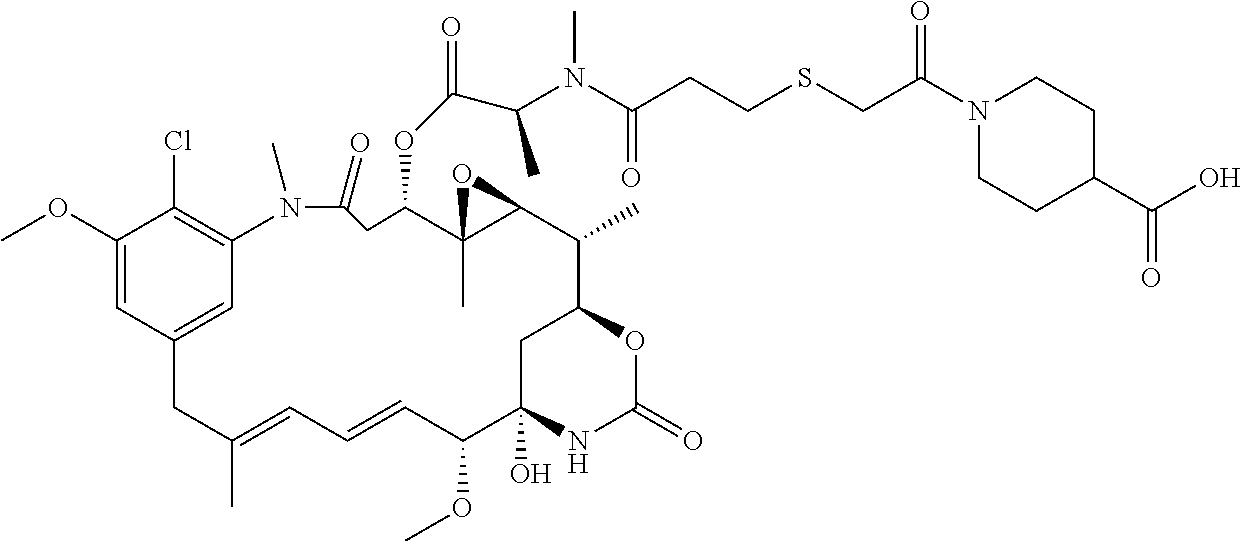






View All Diagrams
| United States Patent Application | 20210017274 |
| Kind Code | A1 |
| Miao; Zhenwei ; et al. | January 21, 2021 |
Drug-Conjugates With a Targeting Molecule and Two Different Drugs
Abstract
There is disclosed an improved ADC (antibody drug conjugate) type composition having at least two different drug payloads conjugated to a single targeting protein. More specifically, the present disclosure attaches a first drug conjugate to a dual Cysteine residue on a targeting protein and a second drug conjugate with a different drug to a Lys residue on the targeting protein.
| Inventors: | Miao; Zhenwei; (San Diego, CA) ; Chen; Gang; (San Diego, CA) ; Zhu; Tong; (San Diego, CA) ; Khasanov; Alisher B.; (San Diego, CA) ; Hong; Yufeng; (San Diego, CA) ; Zhang; Hong D.; (San Diego, CA) ; Chucholowski; Alexander; (San Diego, CA) | ||||||||||
| Applicant: |
|
||||||||||
|---|---|---|---|---|---|---|---|---|---|---|---|
| Assignee: | Sorrento Therapeutics, Inc. San Diego CA |
||||||||||
| Family ID: | 1000005123534 | ||||||||||
| Appl. No.: | 17/037370 | ||||||||||
| Filed: | September 29, 2020 |
Related U.S. Patent Documents
| Application Number | Filing Date | Patent Number | ||
|---|---|---|---|---|
| 14515352 | Oct 15, 2014 | 10836821 | ||
| 17037370 | ||||
| 61891310 | Oct 15, 2013 | |||
| Current U.S. Class: | 1/1 |
| Current CPC Class: | C07K 16/18 20130101; C07K 16/28 20130101; A61K 47/65 20170801; A61K 47/55 20170801; A61K 47/6801 20170801 |
| International Class: | C07K 16/28 20060101 C07K016/28; C07K 16/18 20060101 C07K016/18; A61K 47/68 20060101 A61K047/68; A61K 47/65 20060101 A61K047/65; A61K 47/55 20060101 A61K047/55 |
Claims
1-15. (canceled)
16. A method of preparing a dual-drug conjugate, the method comprising conjugating a first moiety comprising D.sup.1 to a lysine side chain of A and conjugating a second moiety comprising D.sup.2 to cysteine side chains of A, thereby producing a dual-drug conjugate comprising a structure of Formula I ##STR00097## or a pharmaceutically acceptable salt thereof, wherein: A comprises an antibody or antigen-binding antibody fragment; D.sup.1 is an active agent; each L1 is independently a linker comprising at least one N (nitrogen) atom; the nitrogen between the antibody or antigen-binding antibody fragment and the carbonyl of C(O)-L.sup.1-D.sup.1 is the nitrogen of a Lys side chain of the antibody or antigen-binding antibody fragment; D.sup.2 an active agent, wherein D.sup.1 and D.sup.2 are different active agents; each L.sup.2 is independently a linker; the E-component is selected from the group consisting of ##STR00098## L.sup.3 is --(CH.sub.2)--; L.sup.4 is --(CH.sub.2)--; m is 1, 2, 3, 4, 5, 6, 7, 8, 9, or 10; and n is 1, 2, 3, 4, 5, 6, 7, 8, 9, or 10.
17. The method of claim 16, wherein the first moiety is conjugated before conjugation of the second moiety.
18. The method of claim 16, wherein the first moiety is conjugated after conjugation of the second moiety.
19. The method of claim 16, wherein conjugating the first moiety to the lysine side chain of A comprises reacting a compound of formula I-A with a compound of formula I-B to provide a compound of formula I-C: ##STR00099## wherein G is --F, --Cl, --Br, --I, --N.sub.3, --OR, SR, --ONRR, RC(.dbd.O)O--, or RSO.sub.2--O--; and R is optionally substituted alkyl, or optionally substituted aryl.
20. The method of claim 16, wherein conjugating the second moiety to the cysteine side chains of A comprises reacting a compound of formula I-D with a compound of formula I-E to provide a compound of formula I-F: ##STR00100## wherein each X is --Cl, --Br, --I, or RSO.sub.2--O--; and R is optionally substituted alkyl, or optionally substituted aryl.
21. The method of claim 20, wherein the cysteine side chains were reduced with a reducing agent to prepare compound I-D.
22. The method of claim 16, wherein conjugating the second moiety to the cysteine side chains of A comprises reacting a compound of formula II-A with a compound of formula I-E to provide a compound of formula II-B: ##STR00101## wherein each X is --Cl, --Br, --I, or RSO.sub.2--O--; and R is optionally substituted alkyl, or optionally substituted aryl.
23. The method of claim 16, wherein conjugating the first moiety to the lysine side chain of A comprises reacting a compound of formula II-A with a compound of formula I-B to provide a compound of formula I-F: ##STR00102## wherein G is --F, --Cl, --Br, --I, --N.sub.3, --OR, SR, --ONRR, RC(.dbd.O)O--, or RSO.sub.2--O--; and R is optionally substituted alkyl, or optionally substituted aryl.
24. The method of claim 16, wherein: ##STR00103## is: ##STR00104##
25. The method of claim 16, wherein L.sup.1 comprises ##STR00105## where X.sup.1 is N (nitrogen) or CH; Y.sup.1 is N (nitrogen), or CH; and p is 0, 1, or 2.
26. The method of claim 16, wherein L1 comprises ##STR00106##
27. The method of claim 16, wherein D.sup.1 is a tubulin binder, DNA alkylator, DNA intercalator, enzyme inhibitor, immune modulator, peptide, or nucleotide.
28. The method of claim 16, wherein D.sup.2 is a tubulin binder, DNA alkylator, DNA intercalator, enzyme inhibitor, immune modulator, peptide, or nucleotide.
29. The method of claim 16, wherein L1 or L.sup.2 comprises --(CH.sub.2).sub.n-- where n is 1, 2, 3, 4, 5, 6, 7, 8, 9, or 10.
30. The method of claim 16, wherein L1 or L.sup.2 includes --(CH.sub.2CH.sub.2O).sub.n-- where n is 1, 2, 3, 4, 5, 6, 7, 8, 9, or 10.
31. The method of claim 16, wherein the S-linked portion of ##STR00107## comprises a modified L-Alanine residue.
32. The method of claim 16, wherein each ##STR00108## is: ##STR00109## ##STR00110## wherein G is --NH--.
33. The method of claim 16, wherein each ##STR00111## is: ##STR00112## ##STR00113## ##STR00114##
34. The method of claim 16, wherein the dual-drug conjugate is: ##STR00115## ##STR00116## ##STR00117## ##STR00118## or a pharmaceutically acceptable salt thereof, wherein A comprises an antibody or antigen-binding antibody fragment.
35. The method of claim 16, wherein A comprises an antibody.
36. The method of claim 16, wherein A comprises an antigen-binding antibody fragment.
Description
CROSS REFERENCE TO RELATED APPLICATIONS
[0001] This application is a divisional of U.S. patent application Ser. No. 14/515,352, filed Oct. 15, 2014, which claims priority from U.S. Provisional Application No. 61/891,310 filed Oct. 15, 2013, the contents of each of which are incorporated herein by reference in their entirety.
TECHNICAL FIELD
[0002] The present disclosure provides an improved ADC (antibody drug conjugate) type composition having at least two different drug payloads conjugated to a single targeting protein. More specifically, the present disclosure attaches a first drug conjugate to a dual Cysteine residue on a targeting protein and a second drug conjugate with a different drug to a Lys residue on the targeting protein.
BACKGROUND
[0003] An antibody (or antibody fragment) can be linked to a payload drug to form an immunoconjugate that has been termed antibody-drug conjugate, or ADC. The antibody causes the ADC to bind to the target cells. Often the ADC is then internalized by the cell and the drug is released to treat the cell. Because of the targeting, the side effects may be lower than the side effects of systemically administering the drug.
SUMMARY
[0004] The present disclosure provides active agent-conjugates that include at least two different types of drugs. A first drug is conjugated to sulfhydryl groups of a targeting protein on Cys residues within four amino acids of each other, such as on an antibody hinge region, and a second drug conjugated to an amino groups of Lys side chains of the targeting protein.
[0005] Specifically, the present disclosure provides a dual active agent-conjugate having the structure of Formula I:
##STR00001##
or a pharmaceutically acceptable salt thereof, wherein: A is a targeting moiety; each D.sup.1 is independently selected, where each D.sup.1 is an active agent; each L.sup.1 is independently a linker including at least one N (nitrogen) atom; each D.sup.2 is independently selected, where each D.sup.2 includes an active agent; each L.sup.2 is independently a linker; the E-component is an optionally substituted heteroaryl or an optionally substituted heterocyclyl; each L.sup.3 is an optionally substituted C.sub.1-C.sub.6 alkyl, or L.sup.3 may be null, when L.sup.3 is null the sulfur is directly connected to the E-component; and each L.sup.4 is an optionally substituted C.sub.1-C.sub.6 alkyl, or L.sup.4 is null, when L.sup.4 is null the sulfur is directly connected to the E-component; m is 1, 2, 3, 4, 5, 6, 7, 8, 9, or 10; and n is 1, 2, 3, 4, 5, 6, 7, 8, 9, or 10.
[0006] Preferably, the E-component includes a fragment selected from the group consisting of:
##STR00002##
[0007] L.sup.3 is --(CH.sub.2)--; and L.sup.4 is --(CH.sub.2)--. L.sup.3 is null; and L.sup.4 is null.
##STR00003##
[0008] L.sup.1 includes --(CH.sub.2).sub.n-- where n may be 1, 2, 3, 4, 5, 6, 7, 8, 9, or 10. In some embodiments, L.sup.1 includes --(CH.sub.2CH.sub.2O).sub.n-- where n may be 1, 2, 3, 4, 5, 6, 7, 8, 9, or 10. In some embodiments, L.sup.1 includes Val-Cit-PAB, Val-Ala-PAB, Val-Lys(Ac)-PAB, Phe-Lys-PAB, Phe-Lys(Ac)-PAB, D-Val-Leu-Lys, Gly-Gly-Arg, Ala-Ala-Asn-PAB, Ala-PAB, or PAB. In some embodiments, L.sup.1 includes peptide, oligosaccharide, --(CH.sub.2).sub.n--, --(CH.sub.2CH.sub.2O).sub.n--, Val-Cit-PAB, Val-Ala-PAB, Val-Lys(Ac)-PAB, Phe-Lys-PAB, Phe-Lys(Ac)-PAB, D-Val-Leu-Lys, Gly-Gly-Arg, Ala-Ala-Asn-PAB, Ala-PAB, PAB, or combinations thereof. Preferably, L.sup.1 is selected from the group consisting of --(CH.sub.2).sub.n--, --(CH.sub.2CH.sub.2O).sub.n-- wherein n is an integer from 1-10, a peptide,
##STR00004##
wherein X.sup.1 is N (nitrogen) or CH; Y.sup.1 is N (nitrogen), or CH; and p is 0, 1, or 2,
##STR00005##
[0009] L.sup.2 includes --(CH.sub.2).sub.n-- where n may be 1, 2, 3, 4, 5, 6, 7, 8, 9, or 10. In some embodiments, L.sup.2 includes --(CH.sub.2CH.sub.2O).sub.n-- where n is 1, 2, 3, 4, 5, 6, 7, 8, 9, or 10. In some embodiments, L.sup.2 includes Val-Cit-PAB, Val-Ala-PAB, Val-Lys(Ac)-PAB, Phe-Lys-PAB, Phe-Lys(Ac)-PAB, D-Val-Leu-Lys, Gly-Gly-Arg, Ala-Ala-Asn-PAB, Ala-PAB, or PAB. In some embodiments, L.sup.2 includes peptide, oligosaccharide, --(CH.sub.2).sub.n--, --(CH.sub.2CH.sub.2O).sub.n--, Val-Cit-PAB, Val-Ala-PAB, Val-Lys(Ac)-PAB, Phe-Lys-PAB, Phe-Lys(Ac)-PAB, D-Val-Leu-Lys, Gly-Gly-Arg, Ala-Ala-Asn-PAB, Ala-PAB, PAB, or combinations thereof. In some embodiments, L.sup.2 includes a noncleavable unit. In some embodiments, the noncleavable unit includes --(CH.sub.2).sub.n-- where n may be 1, 2, 3, 4, 5, 6, 7, 8, 9, or 10. In some embodiments, the noncleavable unit includes --(CH.sub.2CH.sub.2O).sub.n-- where n may be 1, 2, 3, 4, 5, 6, 7, 8, 9, or 10. In some embodiments, L.sup.2 includes a cleavable unit. Preferably, the cleavable unit comprises a peptide.
[0010] The A component is an antibody (mAB) or fragment thereof. Alternatively, the A component comprises a Cys engineered antibody. In some embodiments, the A component comprises an antibody of which at least one pair of the interheavy chain disulfide bond was eliminated. In some embodiments, the A component comprises at least one modified L-Alanine residue. In some embodiments, the A component comprises at least two modified L-Alanine residues. In some embodiments, at least one L.sup.2 includes --(CH.sub.2).sub.n-- where n may be 1, 2, 3, 4, 5, 6, 7, 8, 9, or 10. In some embodiments, at least one L.sup.2 includes --(CH.sub.2CH.sub.2O).sub.n-- where n may be 1, 2, 3, 4, 5, 6, 7, 8, 9, or 10. In some embodiments, at least one L.sup.2 includes Val-Cit-PAB, Val-Ala-PAB, Val-Lys(Ac)-PAB, Phe-Lys-PAB, Phe-Lys(Ac)-PAB, D-Val-Leu-Lys, Gly-Gly-Arg, Ala-Ala-Asn-PAB, Ala-PAB, or PAB. In some embodiments, at least one L.sup.2 includes a peptide, an oligosaccharide, --(CH.sub.2).sub.n--, --(CH.sub.2CH.sub.2O).sub.n--, Val-Cit-PAB, Val-Ala-PAB, Val-Lys(Ac)-PAB, Phe-Lys-PAB, Phe-Lys(Ac)-PAB, D-Val-Leu-Lys, Gly-Gly-Arg, Ala-Ala-Asn-PAB, Ala-PAB, PAB or combinations thereof.
[0011] Alternatively, the A component comprises at least two modified L-Alanine residues. In some embodiments, at least one L.sup.2 includes --(CH.sub.2).sub.n-- where n may be 1, 2, 3, 4, 5, 6, 7, 8, 9, or 10. In some embodiments, at least one L.sup.2 includes --(CH.sub.2CH.sub.2O).sub.n-- where n may be 1, 2, 3, 4, 5, 6, 7, 8, 9, or 10. In some embodiments, at least one L.sup.2 includes Val-Cit-PAB, Val-Ala-PAB, Val-Lys(Ac)-PAB, Phe-Lys-PAB, Phe-Lys(Ac)-PAB, D-Val-Leu-Lys, Gly-Gly-Arg, Ala-Ala-Asn-PAB, Ala-PAB, or PAB. In some embodiments, at least one L.sup.2 includes a peptide, an oligosaccharide, --(CH.sub.2).sub.n--, --(CH.sub.2CH.sub.2O).sub.n--, Val-Cit-PAB, Val-Ala-PAB, Val-Lys(Ac)-PAB, Phe-Lys-PAB, Phe-Lys(Ac)-PAB, D-Val-Leu-Lys, Gly-Gly-Arg, Ala-Ala-Asn-PAB, Ala-PAB, PAB or combinations thereof.
[0012] A comprises at least one modified n-butyl L-a-amino acid. In some embodiments, A comprises at least one modified L-Lysine residue is from an L-Lysine residue of a peptide before conjugation. In some embodiments, A-NH together comprise at least one modified L-Lysine residue. In some embodiments, the terminal nitrogen of the side chain of an L-Lysine residue of a peptide before conjugation provides the NH of A-NH. In some embodiments, A comprises the --(CH.sub.2).sub.4-- of the side chain of an L-Lysine residue of a peptide before conjugation that provides the at least one A-NH. In some embodiments, A comprises a modified n-butyl a-amino acid residue.
BRIEF DESCRIPTION OF THE FIGURES
[0013] FIG. 1 shows anti-Her-2 (A) dual conjugates (K-lock+C-lock) induces enhanced antiproliferative effect in breast cancer cell lines, compared to either single K-lock or C-lock conjugates. A, SKBR-3 (HER2 3+), B, HCC1954 (HER2 3+), C, MCF-7 (HER2+/-), were all treated with either single conjugates or dual conjugates for 3 d. IC50 was determined for the concentration that showed 50% inhibition of cell growth.
[0014] FIG. 2 shows anti-Her-2 (A) dual conjugates (K-lock+C-lock) induces enhanced antiproliferative effect in breast cancer cell lines, compared to either single K-lock or C-lock conjugates. A, SKBR-3 (HER2 3+), B, HCC1954 (HER2 3+), C, MCF-7 (HER2+/-), were all treated with either single conjugates or dual conjugates for 3 days. Percentage of cell viability at above indicated concentrations were shown and compared with single conjugates.
[0015] FIG. 3 shows anti-Her-2 (A) dual conjugates (K-lock+C-lock) induces enhanced antiproliferative effect in breast cancer cell lines, comparable to the combination of single K-lock and C-lock conjugates. A, SKBR-3 (HER2 3+), B, HCC1954 (HER2 3+), C, MCF-7 (HER2+/-), were all treated with either single conjugates or dual conjugates for 3 d. IC50 was determined as the concentration that showed 50% inhibition of cell growth.
DETAILED DESCRIPTION
[0016] The present disclosure provides a genus of dual-drug improved ADC's (antibody drug conjugates) that comprise two different drugs (D1 and D2), wherein the D1 conjugate is linked to a Lys residue of the targeting protein (preferably an antibody or fragment thereof) that is also called "K-Lock", and the D2 or second drug conjugate is linked to two nearby Cys residues on the targeting protein that is also called "C-Lock." The present disclosure fulfills a long-felt need in the art to be able to use a single targeting protein to deliver into a target cell (such as a cancer cell) two different drug payloads (D1 and D2).
[0017] Table 1 below shows structures of the K-lock conjugation and Table 2 below shows structures for C-Lock conjugation. The present disclosure is based on the ability to do both C-Lock and K-Lock with a single targeting protein.
TABLE-US-00001 TABLE 1 Structures of K lock (Lys conjugation) compounds Compound no structure 3 ##STR00006## 8 ##STR00007## 9 ##STR00008## 10 ##STR00009## 11 ##STR00010## 12 ##STR00011## 13 ##STR00012## 14 ##STR00013##
TABLE-US-00002 TABLE 2 Structures of C-lock (Cys conjugation) compounds Compound ID Structure 17 ##STR00014## 18 ##STR00015## 21 ##STR00016## 26 ##STR00017## 27 ##STR00018## 32 ##STR00019## 37 ##STR00020## 38 ##STR00021## 39 ##STR00022## 40 ##STR00023##
[0018] Table 3 below provides a list of those dual drug conjugates that are exemplified in this disclosure and shows both the D1 drug on the K-Lock side and the D2 drug on the C-Lock side.
TABLE-US-00003 TABLE 3 List of Dual conjugated (K lock and C lock) ADCs K lock (Lys) ID C lock (Cys) ID Dual conjugated ADC (Names used herein) 9 32 A*-9-32 9 18 A-9-18 9 38 A-9-38 9 40 A-9-40 3 17 A-3-17 3 40 A-3-40 3 37 A-3-37 11 21 A-11-21 11 26 A-12-26 12 38 A-12-38 10 38 A-10-38 13 38 A-13-38 13 21 A-13-21 8 21 A-8-21 10 21 A-10-21 14 21 A-14-21 8 26 A-8-26 14 21 A-14-21 14 27 A-14-27 10 26 A-10-26 12 39 A-12-39 *A is an anti-HER2 antibody Structure of the Dual conjugated ADC A-9-32 ##STR00024## Structure of the Dual conjugated ADC A-9-18 ##STR00025## Structure of the Dual conjugated ADC A-9-38 ##STR00026## Structure of the Dual conjugated ADC A-9-40 ##STR00027## Structure of the Dual conjugated ADC A-3-17 ##STR00028## Structure of the Dual conjugated ADC A-3-40 ##STR00029## Structure of the Dual conjugated ADC A-3-37 ##STR00030## Structure of the Dual conjugated ADC A-11-21 ##STR00031## Structure of the Dual conjugated ADC A-11-26 ##STR00032## Structure of the Dual conjugated ADC A-12-38 ##STR00033## Structure of the Dual conjugated ADC A-10-38 ##STR00034## Structure of the Dual conjugated ADC A-13-38 ##STR00035## Structure of the Dual conjugated ADC A-13-21 ##STR00036## Structure of the Dual conjugated ADC A-8-21 ##STR00037## Structure of the Dual conjugated ADC A-10-21 ##STR00038## Structure of the Dual conjugated ADC A-14-21 ##STR00039## Structure of the Dual conjugated ADC A-8-26 ##STR00040## Structure of the Dual conjugated ADC A-14-26 ##STR00041## Structure of the Dual conjugated ADC A-14-27 ##STR00042## Structure of the Dual conjugated ADC A-10-26 ##STR00043## Structure of the Dual conjugated ADC A-12-39 ##STR00044##
[0019] A targeting protein is conjugated to include at least two different types of drugs by using two different conjugation methods, a first conjugation method and a second conjugation method. The first conjugation method to derivatize a polypeptide with a payload can be accomplished using a maleimido or vinyl moiety which can react with individual sulfhydryl group on an antibody via Michael addition reaction. A free sulfhydryl group can be formed by reducing a disulfide bond in an antibody. However, the structural integrity of the targeting protein, such as an antibody, is compromised after opening disulfide bonds and attaching payloads to the exposed free thiols. The compositions and methods provided herein provide conjugation through a cysteine residue without decreased structural stability. The second conjugation method to derivatize a polypeptide with a payload is accomplished by forming an amide bond with a lysine side chain. Due to the presence of large number of lysine side chain amines with similar reactivity, this conjugation strategy can produce complex heterogeneous mixtures. The compositions and methods provided herein provide conjugation through lysine, where enhanced selectivity of the lysine can result in a less heterogenous mixture. The conjugation methods are designated "first" and "second" for convenience of discussion and do not indicate the order of conjugation.
[0020] The term "pharmaceutically acceptable salt" are salts that retain the biological effectiveness and properties of a compound and, which are not biologically or otherwise undesirable for use in a pharmaceutical. The disclosed compounds are capable of forming acid and/or base salts by virtue of the presence of amino and/or carboxyl groups or groups similar thereto. Pharmaceutically acceptable acid addition salts can be formed with inorganic acids and organic acids. Inorganic acids from which salts can be derived include, for example, hydrochloric acid, hydrobromic acid, sulfuric acid, nitric acid, phosphoric acid, and the like. Organic acids from which salts can be derived include, for example, acetic acid, propionic acid, glycolic acid, pyruvic acid, oxalic acid, maleic acid, malonic acid, succinic acid, fumaric acid, tartaric acid, citric acid, benzoic acid, cinnamic acid, mandelic acid, methanesulfonic acid, ethanesulfonic acid, p-toluenesulfonic acid, salicylic acid, and the like. Pharmaceutically acceptable base addition salts can be formed with inorganic and organic bases. Inorganic bases from which salts can be derived include, for example, sodium, potassium, lithium, ammonium, calcium, magnesium, iron, zinc, copper, manganese, aluminum, and the like; particularly preferred are the ammonium, potassium, sodium, calcium and magnesium salts. Organic bases from which salts can be derived include, for example, primary, secondary, and tertiary amines, substituted amines including naturally occurring substituted amines, cyclic amines, basic ion exchange resins, and the like, specifically such as isopropylamine, trimethylamine, diethylamine, triethylamine, tripropylamine, and ethanolamine. Many such salts are known in the art, as described in WO 87/05297, (incorporated by reference herein in its entirety).
[0021] "C.sub.a to C.sub.b" or "C.sub.a-b" in which "a" and "b" are integers refer to the number of carbon atoms in the specified group. That is, the group can contain from "a" to "b", inclusive, carbon atoms. Thus, for example, a "C.sub.1 to C.sub.4 alkyl" or "C.sub.1-4 alkyl" group refers to all alkyl groups having from 1 to 4 carbons, that is, CH.sub.3--, CH.sub.3CH.sub.2--, CH.sub.3CH.sub.2CH.sub.2--, (CH.sub.3).sub.2CH--, CH.sub.3CH.sub.2CH.sub.2CH.sub.2--, CH.sub.3CH.sub.2CH(CH.sub.3)-- and (CH.sub.3).sub.3C--.
[0022] The term "halogen" or "halo" means fluorine, chlorine, bromine, or iodine.
[0023] An "alkyl" refers to a straight or branched hydrocarbon chain that is fully saturated. The alkyl group may have 1 to 20 carbon atoms (whenever it appears herein, a numerical range such as "1 to 20" refers to each integer in the given range; e.g., "1 to 20 carbon atoms" means that the alkyl group may consist of 1 carbon atom, 2 carbon atoms, 3 carbon atoms, etc., up to and including 20 carbon atoms, although the present definition also covers the occurrence of the term "alkyl" where no numerical range is designated). The alkyl group may also be a medium size alkyl having 1 to 9 carbon atoms. The alkyl group could also be a lower alkyl having 1 to 4 carbon atoms. The alkyl group may be designated as "C.sub.1-4 alkyl" or similar designations. By way of example, "C.sub.1-4 alkyl" indicates that there are one to four carbon atoms in the alkyl chain, that is, the alkyl chain is selected from the group consisting of methyl, ethyl, propyl, iso-propyl, n-butyl, iso-butyl, sec-butyl, and t-butyl. Typical alkyl groups include, but are in no way limited to, methyl, ethyl, propyl, isopropyl, butyl, isobutyl, tertiary butyl, pentyl, hexyl.
[0024] An "alkoxy" refers to the formula --OR wherein R is an alkyl as is defined above, such as "C.sub.1-9 alkoxy", including but not limited to methoxy, ethoxy, n-propoxy, 1-methylethoxy (isopropoxy), n-butoxy, iso-butoxy, sec-butoxy, and tert-butoxy.
[0025] An "alkylthio" refers to the formula --SR wherein R is an alkyl as is defined above, such as "C.sub.1-9 alkylthio" and the like, including but not limited to methylmercapto, ethylmercapto, n-propylmercapto, 1-methylethylmercapto (isopropylmercapto), n-butylmercapto, iso-butylmercapto, sec-butylmercapto, tert-butylmercapto.
[0026] An "alkenyl" refers to a straight or branched hydrocarbon chain containing one or more double bonds. The alkenyl group may have 2 to 20 carbon atoms, although the present definition also covers the occurrence of the term "alkenyl" where no numerical range is designated. The alkenyl group may also be a medium size alkenyl having 2 to 9 carbon atoms. The alkenyl group could also be a lower alkenyl having 2 to 4 carbon atoms. The alkenyl group may be designated as "C.sub.2-4 alkenyl" or similar designations. By way of example only, "C.sub.2-4 alkenyl" indicates that there are two to four carbon atoms in the alkenyl chain, that is, the alkenyl chain is selected from the group consisting of ethenyl, propen-1-yl, propen-2-yl, propen-3-yl, buten-1-yl, buten-2-yl, buten-3-yl, buten-4-yl, 1-methyl-propen-1-yl, 2-methyl-propen-1-yl, 1-ethyl-ethen-1-yl, 2-methyl-propen-3-yl, buta-1,3-dienyl, buta-1,2,-dienyl, and buta-1,2-dien-4-yl. Typical alkenyl groups include, but are in no way limited to, ethenyl, propenyl, butenyl, pentenyl, and hexenyl.
[0027] An "alkynyl" is a straight or branched hydrocarbon chain containing one or more triple bonds. The alkynyl group may have 2 to 20 carbon atoms, although the present definition also covers the occurrence of the term "alkynyl" where no numerical range is designated. The alkynyl group may also be a medium size alkynyl having 2 to 9 carbon atoms. The alkynyl group could also be a lower alkynyl having 2 to 4 carbon atoms. The alkynyl group may be designated as "C.sub.2-4 alkynyl" or similar designations. By way of example, "C.sub.2-4 alkynyl" indicates that there are two to four carbon atoms in the alkynyl chain, that is, the alkynyl chain is selected from the group consisting of ethynyl, propyn-1-yl, propyn-2-yl, butyn-1-yl, butyn-3-yl, butyn-4-yl, and 2-butynyl. Alkynyl groups include, for example, ethynyl, propynyl, butynyl, pentynyl, and hexynyl.
[0028] The term "aromatic" refers to a ring or ring system having a conjugated pi electron system and includes both carbocyclic aromatic (e.g., phenyl) and heterocyclic aromatic groups (e.g., pyridine). The term includes monocyclic or fused-ring polycyclic groups provided that the entire ring system is aromatic.
[0029] An "aryloxy" and "arylthio" refers to RO-- and RS--, in which R is an aryl as is defined above, such as "C.sub.6-10 aryloxy" or "C.sub.6-10 arylthio" such as phenyloxy.
[0030] An "aralkyl" or "arylalkyl" is an aryl group connected, as a substituent, via an alkylene group, such as "C.sub.7-14 aralkyl" and the like, including but not limited to benzyl, 2-phenylethyl, 3-phenylpropyl, and naphthylalkyl. In some cases, the alkylene group is a lower alkylene group (i.e., a C.sub.1-4 alkylene group).
[0031] A "heteroaryl" refers to an aromatic ring or ring system that contain(s) one or more heteroatoms, that is, an element other than carbon, including but not limited to, nitrogen, oxygen and sulfur, in the ring backbone. When the heteroaryl is a ring system, every ring in the system is aromatic. The heteroaryl group may have 5-18 ring members (i.e., the number of atoms making up the ring backbone, including carbon atoms and heteroatoms), although the present definition also covers the occurrence of the term "heteroaryl" where no numerical range is designated. In some embodiments, the heteroaryl group has 5 to 10 ring members or 5 to 7 ring members. The heteroaryl group may be designated as "5-7 membered heteroaryl," "5-10 membered heteroaryl," or similar designations. Examples of heteroaryl rings include furyl, thienyl, phthalazinyl, pyrrolyl, oxazolyl, thiazolyl, imidazolyl, pyrazolyl, isoxazolyl, isothiazolyl, triazolyl, thiadiazolyl, pyridinyl, pyridazinyl, pyrimidinyl, pyrazinyl, triazinyl, quinolinyl, isoquinlinyl, benzimidazolyl, benzoxazolyl, benzothiazolyl, indolyl, isoindolyl, and benzothienyl.
[0032] A "heteroaralkyl" or "heteroarylalkyl" is heteroaryl group connected, as a substituent, via an alkylene group. Examples include 2-thienylmethyl, 3-thienylmethyl, furylmethyl, thienylethyl, pyrrolylalkyl, pyridylalkyl, isoxazollylalkyl, and imidazolylalkyl. In some cases, the alkylene group is a lower alkylene group (i.e., a C.sub.1-4 alkylene group).
[0033] A "carbocyclyl" means a non-aromatic cyclic ring or ring system containing only carbon atoms in the ring system backbone. When the carbocyclyl is a ring system, two or more rings may be joined together in a fused, bridged or spiro-connected fashion. Carbocyclyls may have any degree of saturation provided that at least one ring in a ring system is not aromatic. Thus, carbocyclyls include cycloalkyls, cycloalkenyls, and cycloalkynyls. The carbocyclyl group may have 3 to 20 carbon atoms, although the present definition also covers the occurrence of the term "carbocyclyl" where no numerical range is designated. The carbocyclyl group may also be a medium size carbocyclyl having 3 to 10 carbon atoms. The carbocyclyl group could also be a carbocyclyl having 3 to 6 carbon atoms. The carbocyclyl group may be designated as "C.sub.3-6 carbocyclyl" or similar designations. Examples of carbocyclyl rings include, but are not limited to, cyclopropyl, cyclobutyl, cyclopentyl, cyclohexyl, cyclohexenyl, 2,3-dihydro-indene, bicycle[2.2.2]octanyl, adamantyl, and spiro[4.4]nonanyl.
[0034] A "(carbocyclyl)alkyl" is a carbocyclyl group connected, as a substituent, via an alkylene group, such as "C.sub.4-10 (carbocyclyl)alkyl" including, cyclopropylmethyl, cyclobutylmethyl, cyclopropylethyl, cyclopropylbutyl, cyclobutylethyl, cyclopropylisopropyl, cyclopentylmethyl, cyclopentylethyl, cyclohexylmethyl, cyclohexylethyl, cycloheptylmethyl. In some cases, the alkylene group is a lower alkylene group.
[0035] "Cycloalkyl" means a fully saturated carbocyclyl ring or ring system. Examples include cyclopropyl, cyclobutyl, cyclopentyl, and cyclohexyl.
[0036] "Cycloalkenyl" means a carbocyclyl ring or ring system having at least one double bond, wherein no ring in the ring system is aromatic. An example is cyclohexenyl.
[0037] "Heterocyclyl" means a non-aromatic cyclic ring or ring system containing at least one heteroatom in the ring backbone. Heterocyclyls may be joined together in a fused, bridged or spiro-connected fashion. Heterocyclyls may have any degree of saturation provided that at least one ring in the ring system is not aromatic. The heteroatom(s) may be present in either a non-aromatic or aromatic ring in the ring system. The heterocyclyl group may have 3 to 20 ring members (i.e., the number of atoms making up the ring backbone, including carbon atoms and heteroatoms), although the present definition also covers the occurrence of the term "heterocyclyl" where no numerical range is designated. The heterocyclyl group may also be a medium size heterocyclyl having 3 to 10 ring members. The heterocyclyl group could also be a heterocyclyl having 3 to 6 ring members. The heterocyclyl group may be designated as "3-6 membered heterocyclyl" or similar designations. In preferred six membered monocyclic heterocyclyls, the heteroatom(s) are selected from one up to three of O (oxygen), N (nitrogen) or S (sulfur), and in preferred five membered monocyclic heterocyclyls, the heteroatom(s) are selected from one or two heteroatoms selected from O (oxygen), N (nitrogen), or S (sulfur). Examples of heterocyclyl rings include, azepinyl, acridinyl, carbazolyl, cinnolinyl, dioxolanyl, imidazolinyl, imidazolidinyl, morpholinyl, oxiranyl, oxepanyl, thiepanyl, piperidinyl, piperazinyl, dioxopiperazinyl, pyrrolidinyl, pyrrolidonyl, pyrrolidionyl, 4-piperidonyl, pyrazolinyl, pyrazolidinyl, 1,3-dioxinyl, 1,3-dioxanyl, 1,4-dioxinyl, 1,4-dioxanyl, 1,3-oxathianyl, 1,4-oxathiinyl, 1,4-oxathianyl, 2H-1,2-oxazinyl, trioxanyl, hexahydro-1,3,5-triazinyl, 1,3-dioxolyl, 1,3-dioxolanyl, 1,3-dithiolyl, 1,3-dithiolanyl, isoxazolinyl, isoxazolidinyl, oxazolinyl, oxazolidinyl, oxazolidinonyl, thiazolinyl, thiazolidinyl, 1,3-oxathiolanyl, indolinyl, isoindolinyl, tetrahydrofuranyl, tetrahydropyranyl, tetrahydrothiophenyl, tetrahydrothiopyranyl, tetrahydro-1,4-thiazinyl, thiamorpholinyl, dihydrobenzofuranyl, benzimidazolidinyl, and tetrahydroquinoline.
[0038] A "(heterocyclyl)alkyl" is a heterocyclyl group connected, as a substituent, via an alkylene group. Examples include imidazolinylmethyl and indolinylethyl.
[0039] An "acyl" is --C(.dbd.O)R, wherein R is hydrogen, C.sub.1-6 alkyl, C.sub.2-6 alkenyl, C.sub.2-6 alkynyl, C.sub.3-7 carbocyclyl, C.sub.6-10 aryl, 5-10 membered heteroaryl, and 5-10 membered heterocyclyl. Examples include formyl, acetyl, propanoyl, benzoyl, and acryl.
[0040] An "O-carboxy" group is a "--OC(.dbd.O)R" group in which R is selected from hydrogen, C.sub.1-6 alkyl, C.sub.2-6 alkenyl, C.sub.2-6 alkynyl, C.sub.3-7 carbocyclyl, C.sub.6-10 aryl, 5-10 membered heteroaryl, and 5-10 membered heterocyclyl.
[0041] A "C-carboxy" group is a "--C(.dbd.O)OR" group in which R is selected from hydrogen, C.sub.1-6 alkyl, C.sub.2-6 alkenyl, C.sub.2-6 alkynyl, C.sub.3-7 carbocyclyl, C.sub.6-10 aryl, 5-10 membered heteroaryl, and 5-10 membered heterocyclyl, as defined herein. A non-limiting example includes carboxyl (i.e., --C(.dbd.O)OH).
[0042] A "cyano" group is a "--CN" group.
[0043] A "cyanato" group is an "--OCN" group.
[0044] An "isocyanato" group is a "--NCO" group.
[0045] A "thiocyanato" group is a "--SCN" group.
[0046] An "isothiocyanato" group is an "--NCS" group.
[0047] A "sulfinyl" group is an "--S(.dbd.O)R" group in which R is selected from hydrogen, C.sub.1-6 alkyl, C.sub.2-6 alkenyl, C.sub.2-6 alkynyl, C.sub.3-7 carbocyclyl, C.sub.6-10 aryl, 5-10 membered heteroaryl, and 5-10 membered heterocyclyl.
[0048] A "sulfonyl" group is an "--SO.sub.2R" group in which R is selected from hydrogen, C.sub.1-6 alkyl, C.sub.2-6 alkenyl, C.sub.2-6 alkynyl, C.sub.3-7 carbocyclyl, C.sub.6-10 aryl, 5-10 membered heteroaryl, and 5-10 membered heterocyclyl.
[0049] An "S-sulfonamido" group is a "--SO.sub.2NR.sub.AR.sub.B" group in which R.sub.A and R.sub.B are each independently selected from hydrogen, C.sub.1-6 alkyl, C.sub.2-6 alkenyl, C.sub.2-6 alkynyl, C.sub.3-7 carbocyclyl, C.sub.6-10 aryl, 5-10 membered heteroaryl, and 5-10 membered heterocyclyl.
[0050] An "N-sulfonamido" group is a "--N(R.sub.A)SO.sub.2R.sub.B" group in which R.sub.A and R.sub.b are each independently selected from hydrogen, C.sub.1-6 alkyl, C.sub.2-6 alkenyl, C.sub.2-6 alkynyl, C.sub.3-7 carbocyclyl, C.sub.6-10 aryl, 5-10 membered heteroaryl, and 5-10 membered heterocyclyl.
[0051] An "O-carbamyl" group is a "--OC(.dbd.O)NR.sub.AR.sub.B" group in which R.sub.A and R.sub.B are each independently selected from hydrogen, C.sub.1-6 alkyl, C.sub.2-6 alkenyl, C.sub.2-6 alkynyl, C.sub.3-7 carbocyclyl, C.sub.6-10 aryl, 5-10 membered heteroaryl, and 5-10 membered heterocyclyl.
[0052] An "N-carbamyl" group is an "--N(R.sub.A)C(.dbd.O)OR.sub.B" group in which R.sub.A and R.sub.B are each independently selected from hydrogen, C.sub.1-6 alkyl, C.sub.2-6 alkenyl, C.sub.2-6 alkynyl, C.sub.3-7 carbocyclyl, C.sub.6-10 aryl, 5-10 membered heteroaryl, and 5-10 membered heterocyclyl.
[0053] An "O-thiocarbamyl" group is a "--OC(.dbd.S)NR.sub.AR.sub.B" group in which R.sub.A and R.sub.B are each independently selected from hydrogen, C.sub.1-6 alkyl, C.sub.2-6 alkenyl, C.sub.2-6 alkynyl, C.sub.3-7 carbocyclyl, C.sub.6-10 aryl, 5-10 membered heteroaryl, and 5-10 membered heterocyclyl.
[0054] A "urea" group is a "--N(R.sub.A)C(.dbd.O)NR.sub.AR.sub.B" group in which R.sub.A and R.sub.B are each independently selected from hydrogen, C.sub.1-6 alkyl, C.sub.2-6 alkenyl, C.sub.2-6 alkynyl, C.sub.3-7 carbocyclyl, C.sub.6-10 aryl, 5-10 membered heteroaryl, and 5-10 membered heterocyclyl.
[0055] An "N-thiocarbamyl" group is an "--N(R.sub.A)C(.dbd.S)OR.sub.B" group in which R.sub.A and R.sub.B are each independently selected from hydrogen, C.sub.1-6 alkyl, C.sub.2-6 alkenyl, C.sub.2-6 alkynyl, C.sub.3-7 carbocyclyl, C.sub.6-10 aryl, 5-10 membered heteroaryl, and 5-10 membered heterocyclyl.
[0056] A "C-amido" group is a "--C(.dbd.O)NR.sub.AR.sub.B" group in which R.sub.A and R.sub.B are each independently selected from hydrogen, C.sub.1-6 alkyl, C.sub.2-6 alkenyl, C.sub.2-6 alkynyl, C.sub.3-7 carbocyclyl, C.sub.6-10 aryl, 5-10 membered heteroaryl, and 5-10 membered heterocyclyl.
[0057] An "N-amido" group is a "--N(R.sub.A)C(.dbd.O)R.sub.B" group in which R.sub.A and R.sub.B are each independently selected from hydrogen, C.sub.1-6 alkyl, C.sub.2-6 alkenyl, C.sub.2-6 alkynyl, C.sub.3-7 carbocyclyl, C.sub.6-10 aryl, 5-10 membered heteroaryl, and 5-10 membered heterocyclyl.
[0058] An "amino" group is a "--NR.sub.AR.sub.B" group in which R.sub.A and R.sub.B are each independently selected from hydrogen, C.sub.1-6 alkyl, C.sub.2-6 alkenyl, C.sub.2-6 alkynyl, C.sub.3-7 carbocyclyl, C.sub.6-10 aryl, 5-10 membered heteroaryl, and 5-10 membered heterocyclyl. An example is free amino (--NH.sub.2).
[0059] An "aminoalkyl" group is an amino group connected via an alkylene group.
[0060] An "alkoxyalkyl" group is an alkoxy group connected via an alkylene group, such as a "C.sub.2-8 alkoxyalkyl".
[0061] A substituted group is derived from the unsubstituted parent group in which there has been an exchange of one or more hydrogen atoms for another atom or group. Unless otherwise indicated, when a group is deemed to be "substituted," it is meant that the group is substituted with one or more substituent's independently selected from C.sub.1-C.sub.6 alkyl, C.sub.2-C.sub.6 alkenyl, C.sub.2-C.sub.6 alkynyl, C.sub.3-C.sub.7 carbocyclyl (optionally substituted with halo, C.sub.1-C.sub.6 alkyl, C.sub.1-C.sub.6 alkoxy, C.sub.1-C.sub.6 haloalkyl, and C.sub.1-C.sub.6 haloalkoxy), C.sub.3-C.sub.7-carbocyclyl-C.sub.1-C.sub.6-alkyl (optionally substituted with halo, C.sub.1-C.sub.6 alkyl, C.sub.1-C.sub.6 alkoxy, C.sub.1-C.sub.6 haloalkyl, and C.sub.1-C.sub.6 haloalkoxy), 5-10 membered heterocyclyl (optionally substituted with halo, C.sub.1-C.sub.6 alkyl, C.sub.1-C.sub.6 alkoxy, C.sub.1-C.sub.6 haloalkyl, and C.sub.1-C.sub.6 haloalkoxy), 5-10 membered heterocyclyl-C.sub.1-C.sub.6-alkyl (optionally substituted with halo, C.sub.1-C.sub.6 alkyl, C.sub.1-C.sub.6 alkoxy, C.sub.1-C.sub.6 haloalkyl, and C.sub.1-C.sub.6 haloalkoxy), aryl (optionally substituted with halo, C.sub.1-C.sub.6 alkyl, C.sub.1-C.sub.6 alkoxy, C.sub.1-C.sub.6 haloalkyl, and C.sub.1-C.sub.6 haloalkoxy), aryl(C.sub.1-C.sub.6)alkyl (optionally substituted with halo, C.sub.1-C.sub.6 alkyl, C.sub.1-C.sub.6 alkoxy, C.sub.1-C.sub.6 haloalkyl, and C.sub.1-C.sub.6 haloalkoxy), 5-10 membered heteroaryl (optionally substituted with halo, C.sub.1-C.sub.6 alkyl, C.sub.1-C.sub.6 alkoxy, C.sub.1-C.sub.6 haloalkyl, and C.sub.1-C.sub.6 haloalkoxy), 5-10 membered heteroaryl(C.sub.1-C.sub.6)alkyl (optionally substituted with halo, C.sub.1-C.sub.6 alkyl, C.sub.1-C.sub.6 alkoxy, C.sub.1-C.sub.6 haloalkyl, and C.sub.1-C.sub.6 haloalkoxy), halo, cyano, hydroxy, C.sub.1-C.sub.6 alkoxy, C.sub.1-C.sub.6 alkoxy(C.sub.1-C.sub.6)alkyl (i.e., ether), aryloxy, sulfhydryl (mercapto), halo(C.sub.1-C.sub.6)alkyl (e.g., --CF.sub.3), halo(C.sub.1-C.sub.6)alkoxy (e.g., --OCF.sub.3), C.sub.1-C.sub.6 alkylthio, arylthio, amino, amino(C.sub.1-C.sub.6)alkyl, nitro, O-carbamyl, N-carbamyl, O-thiocarbamyl, N-thiocarbamyl, C-amido, N-amido, S-sulfonamido, N-sulfonamido, C-carboxy, O-carboxy, acyl, cyanato, isocyanato, thiocyanato, isothiocyanato, sulfinyl, sulfonyl, and oxo (.dbd.O). Wherever a group is described as "optionally substituted" that group can be substituted with the above substituents.
[0062] Wherever a substituent is depicted as a di-radical (i.e., has two points of attachment to the rest of the molecule), it is to be understood that the substituent can be attached in any directional configuration unless otherwise indicated. For example, a substituent depicted as -AE- or
##STR00045##
includes the substituent being oriented such that the A is attached at the leftmost attachment point of the molecule as well as the case in which A is attached at the rightmost attachment point of the molecule.
[0063] "Subject" as used herein, means a human or a non-human mammal, e.g., a dog, a cat, a mouse, a rat, a cow, a sheep, a pig, a goat, a non-human primate or a bird, e.g., a chicken, as well as any other vertebrate or invertebrate.
Definitions
[0064] As used herein, common organic abbreviations are defined as follows:
Ac Acetyl
[0065] aq. Aqueous BOC or Boc tert-Butoxycarbonyl BrOP bromo tris(dimethylamino) phosphonium hexafluorophosphate Bu n-Butyl .degree. C. Temperature in degrees Centigrade DCM methylene chloride
DEPC Diethylcyanophosphonate
[0066] DIC diisopropylcarbodiimide
DIEA Diisopropylethylamine
DMA N,N-Dimethylformamide
DMF N,N-Dimethylformamide
[0067] EDC 1-Ethyl-3-(3-dimethylaminopropyl)carbodiimide
Et Ethyl
[0068] EtOAc Ethyl acetate
Eq Equivalents
Fmoc 9-Fluorenylmethoxycarbonyl
g Gram(s)
[0069] h Hour (hours) HATU 2-(1H-7-azabenzotriazol-1-yl)-1,1,3,3-tetramethyl uronium hexafluorophosphate
HOBT N-Hydroxybenzotriazole
HOSu N-Hydroxysuccinimide
[0070] HPLC High-performance liquid chromatography LC/MS Liquid chromatography-mass spectrometry
Me Methyl
MeOH Methanol
MeCN Acetonitrile
mL Milliliter(s)
[0071] MS mass spectrometry PAB p-aminobenzyl RP-HPLC reverse phase HPLC rt room temperature t-Bu tert-Butyl
TEA Triethylamine
[0072] Tert, t tertiary TFA Trifluoracetic acid
THF Tetrahydrofuran
[0073] TLC Thin-layer chromatography
.mu.L Microliter(s)
[0074] A general synthesis procedure forms an activated ester (e.g. NHS) from an acid. For example, an acid was dissolved in DCM, and DMF was added to aid dissolution if necessary. N-hydroxysuccinimide (1.5 eq) was added, followed by EDC.HCl (1.5 eq). The reaction mixture was stirred at room temperature for 1 h until most of the acid was consumed. The progress of the reaction was monitored by RP-HPLC. The mixture was then diluted with DCM and washed successively with citric acid (aq. 10%) and brine. The organic layer was dried and concentrated to dryness. The crude product was optionally purified by RP-HPLC or silica gel column chromatography.
Conjugation Methods, Spacers and Linkers Involved
[0075] Some embodiments provide a method of conjugating of a targeting molecule through a spacer or a multifunctional linker. In some embodiments, the spacer or multifunctional linker may include a 2- to 5-atom bridge. In some embodiments, the method includes a single-step or sequential conjugation approach. In some embodiments, the drug-conjugates include a spacer or a multifunctional linker. In some embodiments, the spacer or multifunctional linker may include a noncleavable or cleavable unit such as peptides.
Utilities and Applications
[0076] Some embodiments provide a method of treating a patient in need thereof comprising administering an active agent-conjugate as disclosed and described herein to said patient. In some embodiments, the patient may have cancer, immune diseases or diabetes.
[0077] Some embodiments provide a method of diagnosis or imaging comprising administering an active agent-conjugate as disclosed and described herein to an individual.
Disclosed Compositions
[0078] The disclosed pharmaceutical compositions have a structure in Formula I
##STR00046##
or a pharmaceutically acceptable salt thereof, wherein: A is a targeting protein; each D.sup.1 is a first active agent; each L.sup.1 is independently a linker including at least one N (nitrogen) atom; each D.sup.2 is a second active agent; each L.sup.2 is independently a linker; the E-component is an optionally substituted heteroaryl or an optionally substituted heterocyclyl; each L.sup.3 is an optionally substituted C.sub.1-C.sub.6 alkyl, or L.sup.3 may be null, when L.sup.3 is null the sulfur is directly connected to the E-component; and each L.sup.4 is an optionally substituted C.sub.1-C.sub.6 alkyl, or L.sup.4 may be null, when L.sup.4 is null the sulfur is directly connected to the E-component; m and n are independently integers from 1-10.
[0079] Preferably, A is selected from the group consisting of a monoclonal antibody (mAB), and an antibody fragment.
[0080] D.sup.1 and D.sup.2 are different drug compounds, preferably an anti-cancer drug or an immune modulator. Examples of D1 and D2 are tubulin binders, DNA alkylating agents, HSP90 inhibitors, DNA topoisomerase inhibitors, anti-epigenetic agents, HDAC inhibitors, anti-metabolism agents, proteasome inhibitors, an siRNA, an antisense DNA, epothilone A, epothilone B, or paclitaxel.
[0081] L.sup.1 may include a spacer or a multifunctional linker. L.sup.1 may include a spacer and a multifunctional linker. In some embodiments, L.sup.1 may include a multifunctional linker. In some embodiments, each L.sup.1 may be a linker, wherein the linker may be cleavable or non-cleavable under biological conditions. In some embodiments, the linker may be cleavable by an enzyme. In some embodiments, L.sup.1 may include Linker.
[0082] In some embodiments, L.sup.2 may include a spacer or a multifunctional linker. In some embodiments, L.sup.2 may include a spacer and a multifunctional linker. In some embodiments, L.sup.2 may include a multifunctional linker. In some embodiments, each L.sup.2 may be a linker, wherein the linker may be cleavable or non-cleavable under biological conditions. In some embodiments, the linker may be cleavable by an enzyme. In some embodiments, L.sup.2 may include Linker.
[0083] L.sup.2 includes a cyclic group including at least one N (nitrogen) atom. In some embodiments, L.sup.2 includes a cyclic group including at least two N (nitrogen) atoms. In some embodiments, L.sup.2 includes a cyclic group including at least one N (nitrogen) atom and a spacer.
[0084] A comprises at least one modified L-Alanine residue. In some embodiments, A comprises at least two modified L-Alanine residues. In some embodiments, A comprises at least one modified L-Alanine residue that is connected to at least one sulfur. In some embodiments, at least one modified L-Alanine residue is from an L-Cysteine residue of a peptide before conjugation.
[0085] A comprises at least one modified n-butyl L-a-amino acid. In some embodiments, A comprises at least one modified L-Lysine residue is from an L-Lysine residue of a peptide before conjugation. In some embodiments, A-NH together comprise at least one modified L-Lysine residue. In some embodiments, the terminal nitrogen of the side chain of an L-Lysine residue of a peptide before conjugation provides the NH of A-NH of Formula I. In some embodiments, A comprises the --(CH.sub.2).sub.4-- of the side chain of an L-Lysine residue of a peptide before conjugation that provides the at least one A-NH of Formula I. In some embodiments, A comprises a modified n-butyl a-amino acid residue.
[0086] Linker may be a peptide.
[0087] Linker may include an oligosaccharide. For example, Linker may include chitosan. In some embodiments, L.sup.2 may include Linker and --(CH.sub.2).sub.n-- where n is 1, 2, 3, 4, 5, 6, 7, 8, 9, or 10. In some embodiments, L.sup.2 may include Linker and --(CH.sub.2CH.sub.2O).sub.n-- where n is 1, 2, 3, 4, 5, 6, 7, 8, 9, or 10.
[0088] Linker may include --(CH.sub.2).sub.n-- where n is 1, 2, 3, 4, 5, 6, 7, 8, 9, or 10.
[0089] Linker may include --(CH.sub.2CH.sub.2O).sub.n-- where n is 1, 2, 3, 4, 5, 6, 7, 8, 9, or 10.
[0090] Linker may include Val-Cit-PAB, Val-Ala-PAB, Val-Lys(Ac)-PAB, Phe-Lys-PAB, Phe-Lys(Ac)-PAB, D-Val-Leu-Lys, Gly-Gly-Arg, Ala-Ala-Asn-PAB, Ala-PAB, PAB, or the like.
[0091] Linker may include any combination of peptide, oligosaccharide, --(CH.sub.2).sub.n--, --(CH.sub.2CH.sub.2O).sub.n--, Val-Cit-PAB, Val-Ala-PAB, Val-Lys(Ac)-PAB, Phe-Lys-PAB, Phe-Lys(Ac)-PAB, D-Val-Leu-Lys, Gly-Gly-Arg, Ala-Ala-Asn-PAB, Ala-PAB, PAB, and the like.
[0092] A spacer is any combination of peptide, oligosaccharide, --(CH.sub.2).sub.n--, --(CH.sub.2CH.sub.2O).sub.n--, Val-Cit-PAB, Val-Ala-PAB, Val-Lys(Ac)-PAB, Phe-Lys-PAB, Phe-Lys(Ac)-PAB, D-Val-Leu-Lys, Gly-Gly-Arg, Ala-Ala-Asn-PAB, Ala-PAB, PAB.
##STR00047##
includes a 4-carbon bridge.
[0093] L.sup.3, L.sup.4 and a portion of the E-component include a 4-carbon bridge.
##STR00048##
includes,
##STR00049##
[0094] The S-linked portion of
##STR00050##
comprises a modified L-Alanine residue, wherein
##STR00051##
connects to a sulfur of a reduced disulfide bond through a bridge containing 2 to 5 atoms. For example, the structure indicated by
##STR00052##
includes a fragment selected from the group consisting of:
##STR00053##
[0095] The S-linked (sulfur-linked) portion of
##STR00054##
comprises a modified L-Alanine residue. In some embodiments, the S-linked (sulfur-linked) portion of
##STR00055##
comprises a modified L-Alanine residue wherein the modified L-Alanine component of
##STR00056##
is from an L-Cysteine residue of a peptide before conjugation. Each sulfur of
##STR00057##
is from an L-Cysteine of a peptide before conjugation.
[0096] The structural component
##STR00058##
is:
##STR00059##
[0097] The E-component includes a fragment selected from the group consisting of:
##STR00060##
[0098] L.sup.1 may include,
##STR00061##
[0099] The active agent may be selected from the group consisting of tubulin binders, DNA alkylators, DNA intercalator, enzyme inhibitors, immune modulators, peptides, and nucleotides.
[0100] At least one L.sup.1 or L.sup.2 includes --(CH.sub.2).sub.n-- where n is 1, 2, 3, 4, 5, 6, 7, 8, 9, or 10. In some embodiments, at least one L.sup.1 or L.sup.2 includes --(CH.sub.2CH.sub.2O).sub.n-- where n is 1, 2, 3, 4, 5, 6, 7, 8, 9, or 10. In some embodiments, at least one L.sup.1 or L.sup.2 includes Val-Cit-PAB, Val-Ala-PAB, Val-Lys(Ac)-PAB, Phe-Lys-PAB, Phe-Lys(Ac)-PAB, D-Val-Leu-Lys, Gly-Gly-Arg, Ala-Ala-Asn-PAB, Ala-PAB, or PAB. In some embodiments, at least one L.sup.1 or L.sup.2 includes a peptide, an oligosaccharide, --(CH.sub.2).sub.n--, --(CH.sub.2CH.sub.2O).sub.n--, Val-Cit-PAB, Val-Ala-PAB, Val-Lys(Ac)-PAB, Phe-Lys-PAB, Phe-Lys(Ac)-PAB, D-Val-Leu-Lys, Gly-Gly-Arg, Ala-Ala-Asn-PAB, Ala-PAB, or PAB.
[0101] The targeting moiety may be an antibody. In some embodiments, the targeting moiety may be a monoclonal antibody (mAb). The A component comprises a humanized antibody. In some embodiments, the A component comprises a chimeric antibody. In some embodiments, the A component comprises a bispecific antibody. In some embodiments, the targeting moiety may be an antibody fragment, surrogate, or variant.
[0102] The targeting moiety may be HuM195-Ac-225, HuM195-Bi-213, Anyara (naptumomab estafenatox; ABR-217620), AS1409, Zevalin (ibritumomab tiuxetan), BIIB015, BT-062, Neuradiab, CDX-1307, CR011-vcMMAE, Trastuzumab-DM1 (R3502), Bexxar (tositumomab), IMGN242, IMGN388, IMGN901, .sup.131I-labetuzumab, IMMU-102 (.sup.90Y-epratuzumab), IMMU-107 (.sup.90Y-clivatuzumab tetraxetan), MDX-1203, CAT-8015, EMD 273063 (huI4.18-IL2), Tucotuzumab celmoleukin (EMD 273066; huKS-IL2), .sup.188Re-PTI-6D2, Cotara, L19-IL2, Teleukin (F16-IL2), Tenarad (F16-.sup.131I), L19-.sup.131I, L19-TNF, PSMA-ADC, DI-Leu16-IL2, SAR3419, SGN-35, or CMC544. In some embodiments, the targeting moiety may comprise, consist of, or consist essentially of the antibody portion of HuM195-Ac-225, HuM195-Bi-213, Anyara (naptumomab estafenatox; ABR-217620), AS1409, Zevalin (ibritumomab tiuxetan), BIIB015, BT-062, Neuradiab, CDX-1307, CR011-vcMMAE, Trastuzumab-DM1 (R3502), Bexxar (tositumomab), IMGN242, IMGN388, IMGN901, .sup.131I-labetuzumab, IMMU-102 (.sup.90Y-epratuzumab), IMMU-107 (.sup.90Y-clivatuzumab tetraxetan), MDX-1203, CAT-8015, EMD 273063 (hu14.18-IL2), Tucotuzumab celmoleukin (EMD 273066; huKS-IL2), .sup.188Re-PTI-6D2, Cotara, L19-IL2, Teleukin (F16-IL2), Tenarad (F16-.sup.131I), L19-.sup.131I, L19-TNF, PSMA-ADC, DI-Leu16-IL2, SAR3419, SGN-35, or CMC544.
[0103] The targeting moiety may be Brentuximab vedotin, Trastuzumab emtansine, Inotuzumab ozogamicin, Lorvotuzumab mertansine, Glembatumumab vedotin, SAR3419, Moxetumomab pasudotox, Moxetumomab pasudotox, AGS-16M8F, AGS-16M8F, BIIB-015, BT-062, IMGN-388, or IMGN-388.
[0104] The targeting moiety may comprise, consist of, or consist essentially of the antibody portion of Brentuximab vedotin, Trastuzumab emtansine, Inotuzumab ozogamicin, Lorvotuzumab mertansine, Glembatumumab vedotin, SAR3419, Moxetumomab pasudotox, Moxetumomab pasudotox, AGS-16M8F, AGS-16M8F, BIIB-015, BT-062, IMGN-388, or IMGN-388.
[0105] The targeting moiety may comprise, consist of, or consist essentially of Brentuximab, Inotuzumab, Gemtuzumab, Milatuzumab, Trastuzumab, Glembatumomab, Lorvotuzumab, or Labestuzumab.
Conjugation Method I
##STR00062##
[0106] Scheme I. G is selected from the group consisting of --F, --Cl, --Br, --I, --N.sub.3, --OR, SR, --ONRR, RC(.dbd.O)O--, and RSO.sub.2--O--; and R is optionally substituted alkyl, or optionally substituted aryl.
General Conjugation Procedure I-A:
[0107] To a solution of 0.5-50 mgs/mL of I-A in buffer at pH 6.0-9.0 with 0-30% organic solvent, is added 0.1-10 eq of activated carboxylic component I-B in a manner of portion wise or continuous flow. The reaction is performed at 0-40.degree. C. for 0.5-50 hours with gentle stirring or shaking, monitored by HIC-HPLC. The resultant crude ADC product undergoes necessary down-stream steps of desalt, buffet changes/formulation, and optionally, purification, using the state-of-art procedures. The ADC product I-C is characterized by HIC-HPLC, SEC, RP-HPLC, and optionally LC-MS.
##STR00063##
Scheme I. X is selected from the group consisting of --Cl, --Br, --I, and RSO.sub.2--O--; and R is optionally substituted alkyl, or optionally substituted aryl
General Conjugation Procedure I-B:
[0108] To the ADC product I-C, 0.5-50 mgs/mL, in a certain buffet at pH 5.0-9.0, such as PBS, is added 0.5-100 eq of reducing agent such as TCEP and DTT to afford intermediate I-D. The reduction is performed at 0-40.degree. C. for 0.5-40 hours with gentle stirring or shaking, and then the reducing agent is removed by column or ultrafiltration. To intermediate I-D, 0.5-50 mgs/mL, in a certain buffet at pH 5.0-9.0, such as PBS, with 0-30% of organic co-solvent such as DMA, is added 0.5-10 eq of the activated drug-linker reactant I-E. The reaction is conducted at 0-40.degree. C. for 0.5-40 hours with gentle stirring or shaking, monitored by HIC-HPLC. The resultant crude ADC product I-E undergoes necessary down-stream steps of desalt, buffet changes/formulation, and optionally, purification, using the state-of-art procedures. The final ADC product I-E is characterized by HIC-HPLC, SEC, RP-HPLC, and optionally LC-MS.
Conjugation Method II
##STR00064##
[0109] General Conjugation Procedure II-A:
[0110] To a mixture of I-A, 0.5-50 mgs/mL, in a certain buffet at pH 5.0-9.0, such as PBS, is added 0.5-100 eq of reducing agent such as TCEP and DTT to afford intermediate II-A. The reduction is performed at 0-40.degree. C. for 0.5-40 hours with gentle stirring or shaking, and then the reducing agent is removed by column or ultrafiltration.
##STR00065##
Scheme IV. X is selected from the group consisting of --Cl, --Br, --I, and RSO.sub.2--O--; and R is optionally substituted alkyl, or optionally substituted aryl
General Conjugation Procedure II-B:
[0111] To intermediate II-A, 0.5-50 mgs/mL, in a certain buffet at pH 5.0-9.0, such as PBS, with 0-30% of organic co-solvent such as DMA, is added 0.5-10 eq of the activated drug-linker reactant I-E. The reaction is conducted at 0-40.degree. C. for 0.5-40 hours with gentle stirring or shaking, monitored by HIC-HPLC. The resultant crude ADC product II-B undergoes necessary down-stream steps of desalt, buffet changes/formulation, and optionally, purification, using the state-of-art procedures.
[0112] To a solution of 0.5-50 mgs/mL of II-B in buffer at pH 6.0-9.0 with 0-30% organic solvent, is added 0.1-10 eq of activated carboxylic component I-B in a manner of portion wise or continuous flow. The reaction is performed at 0-40.degree. C. for 0.5-50 hours with gentle stirring or shaking, monitored by HIC-HPLC. The resultant crude ADC product I-F undergoes necessary down-stream steps of desalt, buffet changes/formulation, and optionally, purification, using the state-of-art procedures. The ADC product I-F is characterized by HIC-HPLC, SEC, RP-HPLC, and optionally LC-MS.
[0113] Examples of activated carboxylic component I-B include:
##STR00066## ##STR00067##
wherein G is selected from the group consisting of --F, --Cl, --Br, --I, --N.sub.3, --OR, SR, --ONRR, RC(.dbd.O)O--, and RSO.sub.2--O--; and R is optionally substituted alkyl, or optionally substituted aryl.
[0114] Examples of activated drug-linker reactant I-E are:
##STR00068## ##STR00069## ##STR00070##
Examples of compounds of Formula I:
##STR00071## ##STR00072## ##STR00073## ##STR00074## ##STR00075## ##STR00076## ##STR00077## ##STR00078## ##STR00079##
Example 1
[0115] This example illustrates the synthesis of compound 3.
##STR00080##
To a solution of compound 1 (74 mg, 0.1 mmol) in THF (5 mL) was added bromoacetic acid (70 mg, 5 eq.), followed by aq. saturated NaHCO.sub.3 (2 mL). The mixture was stirred at room temperature for 3 h and then acidified with 1N hydrochloric acid. The mixture was extracted with ethyl acetate and the organic layer was dried and concentrated. The crude product was purified by RP-HPLC to give compound 2 as a white powder after lyophilization (72 mg, 91%). MS m/z 795.5 [M+H].sup.+.
[0116] Compound 2 (72 mg) was converted to its corresponding NHS ester (General procedure). The NHS ester was dissolved in THF (2 mL). A solution of 4-piperidine carboxylic acid (60 mg) in aq. saturated NaHCO.sub.3 (1 mL) was added and the mixture was stirred at room temperature for 1 h. The mixture was then acidified with acetic acid and concentrated to dryness. The residue was purified by RP-HPLC to give compound 3 as a white powder (63 mg). MS m/z 906.6 [M+H].sup.+.
Example 2
[0117] This example illustrates the synthesis of compound 8.
##STR00081##
[0118] To a stirred solution of compound 4 (95 mg, 0.2 mmol) and compound 5 (TFA salt, 146 mg, 0.2 mmol, prepared as described in WO 2013/173392) in DMF (4 mL) was added DIEA (0.14 mL), followed by HATU (80 mg). After 10 min, piperidine (0.4 mL) was added to the reaction and the mixture was stirred at room temperature for 30 min. The reaction mixture was concentrated and the residue was purified by RP-HPLC to give compound 6 as TFA salt (141 mg, 73%). MS m/z 850.5 [M+H].sup.+.
[0119] Compound 6 (141 mg) and 7 (37 mg) were dissolved in DMF (3 mL). DIEA (0.1 mL) was added, followed by HATU (57 mg). The reaction was stirred at room temperature for 30 min. 1N solution of aq. NaOH (2 mL) was added and the reaction was stirred at room temperature for 2 h. Acetic acid (0.5 mL) was added to the reaction and the mixture was concentrated. The residue was purified by RP-HPLC to give compound 8 as a white powder (115 mg). MS m/z 1061.5 [M+H]+.
Example 3
TABLE-US-00004 [0120] TABLE 4 Compound ID Structure 9 ##STR00082## 10 ##STR00083## 11 ##STR00084## 12 ##STR00085## 13 ##STR00086## 14 ##STR00087##
[0121] Compounds 9, 10, 11, 12, 13, and 14 were prepared as described in WO 2013/173392, the disclosure of which is incorporated by reference herein.
Example 4
##STR00088##
[0123] To a solution of compound 15 (0.1 mmol, prepared as described in WO 2013/173392, the disclosure of which is incorporated by reference herein) in THF (3 mL) was added a solution of compound 16 (0.15 mmol, 67 mg) in acetonitrile/water (1/1, v/v, 1 mL), followed by DIEA (50 .mu.L). After 30 min, the reaction was acidified and concentrated. The residue was purified by reverse phase HPLC to give compound 17 as a white solid (87 mg). MS m/z 1243.6 [M+H]+.
Example 5
##STR00089##
[0124] Compound 2 (0.1 mmol, 80 mg) and compound 16 (0.1 mmol, 45 mg) were dissolved in DCM/DMF (10/1, v/v, 3 mL). DIEA (20 .mu.L) was added, followed by DIC (25 .mu.L). The mixture was stirred at room temperature for 10 min. DCM was evaporated and the residue was purified by reverse phase HPLC to give compound 18 as a white powder (66 mg, 53%). MS m/z 1130.6 [M+H]+.
Example 6
##STR00090##
[0126] Compound 19 (0.06 mmol, 36 mg) and compound 20 (0.05 mmol, 60 mg, TFA salt) were dissolved in DCM/DMF (4/1, v/v, 3 mL). DIEA (25 .mu.L) was added, followed by DIC (15 .mu.L). The mixture was stirred at room temperature for 10 min. DCM was evaporated and the residue was purified by reverse phase HPLC to give compound 21 as a white powder (41 mg, 49%). MS m/z 1572.8 [M+H].sup.+.
Example 7
##STR00091##
[0128] To a solution of compound 22 (54 mg, 0.1 mmol) in anhydrous DMF (3 mL) was added compound 23 (80 mg) and DIEA (20 .mu.L). The mixture was stirred at room temperature for 2 h. Piperidine (40 .mu.L) was added. After 3 h, the mixture was added dropwise to 100 mL of ether under vigorous stirring. The precipitated solid was collected and purified by reverse phase HPLC to give compound 24 as a yellow solid (75 mg). MS m/z 947.3 [M+H].sup.+.
[0129] Compound 24 (75 mg) and compound 25 (42 mg) were dissolved in DCM/DMF (4/1, v/v, 3 mL). DIEA (20 .mu.L) was added, followed by DIC (20 .mu.L). The mixture was stirred at room temperature for 20 min. DCM was evaporated and the residue was purified by reverse phase HPLC to give compound 26 as a yellow powder (48 mg). MS m/z 1447.5 [M+H].sup.+.
Example 8
##STR00092##
[0131] Compound 27 was synthesized from Bleomycin using the same procedure as described for compound 26. MS m/z 2320.8 [M+H].sup.+.
Example 9
##STR00093##
[0133] Preparation of compound 30: To a solution of compound 28 (97 mg, 0.125 mmol) in 3 mL of DMF was added HATU (48 mg, 0.125 mmol), DIEA (52 mg, 0.4 mmol), and compound 29 (100 mg, 0.125 mmol). After 1 h, to the mixture was added piperidine (300 uL) and the mixture was stirred for 10 min. Then the mixture was evaporated and purified by HPLC to give compound 30 (83 mg, 50%). MS m/z 1224.5 (M+H).
[0134] Preparation of compound 32: To a solution of compound 30 (26 mg, 0.074 mmol) in 1 mL of DCM was added DIC (46 mg, 0.037 mmol). After 10 min, a solution of compound 31 (41 mg, 0.031 mmol) and DIEA (17 .mu.L) in 2 mL of DCM was added and the mixture was stirred for 30 min. The solvent was evaporated under vacuum and the residue was purified by HPLC to give compound 32 (30 mg, 63%). MS m/z 1554.4 (M+H).
Example 10
Preparation of Compound 10:
##STR00094##
[0136] Preparation of compound 35: To a solution of compound 33 (64 mg, 0.077 mmol) in 3 mL of DMF was added 34 (97 mg, 0.077 mmol), HOBt (5 mg, 0.04 mmol) and DIEA (13 mg, 0.1 mmol). After 24 h, reaction was done by HPLC, and 300 .mu.L of piperidine was added. After 1 h, the mixture was purified by HPLC to give compound 35 (76 mg, 62%). MS m/z 1607.7 (M+H).
[0137] Preparation of compound 37: To a solution of compound 36 (31 mg, 0.09 mmol) in 1 mL of DCM was added DIC (60 mg, 0.045 mmol). After 10 min, a solution of compound 35 (77 mg, 0.045 mmol) and DIEA (25 .mu.L) in 2 mL of DCM was added and the mixture was stirred for 30 min. The solvent was evaporated under vacuum and the residue was purified by HPLC to give compound 37 (60 mg, 69%). MS m/z 1930.6 (M+H).
Example 11
##STR00095##
[0139] Compounds 38 and 39 were prepared as described in WO 2013/173391, the disclosure of which is incorporated by reference herein.
Example 12
##STR00096##
[0141] Compound 40 was synthesized from compound HTI-286 using the same procedure as described for compound 26. MS m/z 1366.7 [M+H].sup.+.
Example 13
[0142] This example provides the results of EC50 assays of the designated dual drug conjugated antibodies measured in vitro in specified cells.
TABLE-US-00005 TABLE 5.1 Dual Cytotoxic activity EC50 (nM) conjugated MDA- MDA- ADC SKBR-3 HCC1954 BT474 MB-175 SKOV_3 MCF-7 468 A-9-38 0.057 0.072 N/D N/D N/D >100 >100 A-3-17 N/D N/D 0.188 0.322 N/D 16.08 23.5 A-11-21 0.67 0.136 31.99 N/D 0.537 34.01 37.52 A-12-38 0.062 0.036 N/D N/D N/D >100 >100 A-10-38 0.081 0.1 N/D N/D N/D >100 >100 A-13-38 0.066 0.04 N/D N/D N/D >100 >100 A-13-21 N/D N/D >100 N/D 0.4 N/D N/D A-8-21 0.12 0.1711 10.74 N/D 1.986 >100 48.61 A-10-21 0.03 0.039 N/D N/D N/D >100 32.72 A-14-21 >100 0.509 N/D N/D N/D >100 >100 A-14-27 >100 >100 N/D N/D N/D >100 >100 A-12-39 0.028 0.024 0.132 N/D 0.326 5.816 >100 A-9 0.041 0.138 0.423 3.635 0.405 >100 >100 A-3 0.055 0.16 >100 3.669 1.716 17.84 24.85 A-11 0.046 0.04 0.219 N/D 0.518 14.3 6.486 A-12 0.047 0.03 0.2 N/D 0.388 >100 >100 A-10 0.015 0.008 N/D N/D N/D >100 >100 A-13 0.028 0.014 0.169 N/D 0.307 >100 >100 A-21 0.074 0.586 9.325 N/D 0.841 >100 53.53 A-8 >100 >100 N/D N/D N/D >100 >100 A-38 0.626 0.81 N/D N/D N/D >100 >100 A-27 >100 >100 N/D N/D N/D >100 >100 A-39 0.038 0.023 0.093 N/D 0.225 >100 >100 A-17 N/D N/D 0.153 0.186 N/D >100 >100
TABLE-US-00006 TABLE 5.2 Dual conjugated Cytotoxic activity EC50 (nM) ADC SKBR-3 HCC1954 BT474 MDA-MB-175 SKOV_3 MCF-7 A-9-38 0.057 0.072 N/D N/D N/D >100 A-3-17 N/D N/D 0.188 0.322 N/D 16.08 A-11-21 0.67 0.136 31.99 N/D 0.537 34.01 A-12-38 0.062 0.036 N/D N/D N/D >100 A-10-38 0.081 0.1 N/D N/D N/D >100 A-13-38 0.066 0.04 N/D N/D N/D >100 A-13-21 N/D N/D >100 N/D 0.4 N/D A-8-21 0.12 0.1711 10.74 N/D 1.986 >100 A-10-21 0.03 0.039 N/D N/D N/D >100 A-14-21 >100 0.509 N/D N/D N/D >100 A-14-27 >100 >100 N/D N/D N/D >100 A-12-39 0.028 0.024 0.132 N/D 0.326 5.816 A-9 0.041 0.138 0.423 3.635 0.405 >100 A-3 0.055 0.16 >100 3.669 1.716 17.84 A-11 0.046 0.04 0.219 N/D 0.518 14.3 A-12 0.047 0.03 0.2 N/D 0.388 >100 A-10 0.015 0.008 N/D N/D N/D >100 A-13 0.028 0.014 0.169 N/D 0.307 >100 A-21 0.074 0.586 9.325 N/D 0.841 >100 A-8 >100 >100 N/D N/D N/D >100 A-38 0.626 0.81 N/D N/D N/D >100 A-27 >100 >100 N/D N/D N/D >100 A-39 0.038 0.023 0.093 N/D 0.225 >100 A-17 N/D N/D 0.153 0.186 N/D >100
TABLE-US-00007 TABLE 5.3 Dual conjugated Cytotoxic activity EC50 (nM) ADC SKBR-3 HCC1954 BT474 MDA-MB-175 SKOV_3 MCF-7 A-9-38 0.057 0.072 N/D N/D N/D >100 A-3-17 N/D N/D 0.188 0.322 N/D 16.08 A-11-21 0.67 0.136 31.99 N/D 0.537 34.01 A-12-38 0.062 0.036 N/D N/D N/D >100 A-10-38 0.081 0.1 N/D N/D N/D >100 A-13-38 0.066 0.04 N/D N/D N/D >100 A-13-21 N/D N/D >100 N/D 0.4 N/D A-8-21 0.12 0.1711 10.74 N/D 1.986 >100 A-10-21 0.03 0.039 N/D N/D N/D >100 A-14-21 >100 0.509 N/D N/D N/D >100 A-14-27 >100 >100 N/D N/D N/D >100 A-12-39 0.028 0.024 0.132 N/D 0.326 5.816
TABLE-US-00008 TABLE 5.4 Dual Cytotoxic activity EC50 (nM) conjugated MDA- MDA- ADC SKBR-3 HCC1954 BT474 MB-175 SKOV_3 MCF-7 468 A-9-38 0.057 0.072 N/D N/D N/D >100 >100 A-3-17 N/D N/D 0.188 0.322 N/D 16.08 23.5 A-11-21 0.67 0.136 31.99 N/D 0.537 34.01 37.52 A-12-38 0.062 0.036 N/D N/D N/D >100 >100 A-10-38 0.081 0.1 N/D N/D N/D >100 >100 A-13-38 0.066 0.04 N/D N/D N/D >100 >100 A-13-21 N/D N/D >100 N/D 0.4 N/D N/D A-8-21 0.12 0.1711 10.74 N/D 1.986 >100 48.61 A-10-21 0.03 0.039 N/D N/D N/D >100 32.72 A-14-21 >100 0.509 N/D N/D N/D >100 >100 A-14-27 >100 >100 N/D N/D N/D >100 >100 A-12-39 0.028 0.024 0.132 N/D 0.326 5.816 >100
Example 14
[0143] This example provides a description of the comparative activity data provided in the Figures. On the first day, a specific tumor cell line, such as SKBR-3, was plated at 20-30% confluence in 100 .mu.l culture medium on a 96 well culture plate (Corning). The cells were incubated in a CO.sub.2 incubator at 37.degree. C. overnight. On second day, a dual conjugate ADC, such as A-3-17, was serially diluted to the culture medium at 19:60 ratio, with starting concentration of 100 nM. 5 .mu.l of the serially diluted conjugates were added to the 96 well plate containing SKRB-3 cells. SKBR-3 cells with dual conjugate ADC, A-3-17 were incubated at 37.degree. C. for 72 hours. The viability of tumor cell treated with dual conjugate ADC, A-3-17 was then measured using a cell viability kit, CelltitreGlo (Promega G-7573) according to the manufacturer protocol on a plate reader (SpectraMax L from Molecular device). The IC.sub.50 value, 50% inhibition of cell growth was calculated using a curve fitting software, Graphpad Prism.
[0144] FIG. 1 shows anti-Her-2 (A) dual conjugates (K-lock+C-lock) induces enhanced antiproliferative effect in breast cancer cell lines, compared to either single K-lock or C-lock conjugates. A, SKBR-3 (HER2 3+), B, HCC1954 (HER2 3+), C, MCF-7 (HER2+/-), were all treated with either single conjugates or dual conjugates for 3 d. IC.sub.50 was determined for the concentration that showed 50% inhibition of cell growth.
[0145] FIG. 2 shows anti-Her-2 (A) dual conjugates (K-lock+C-lock) induces enhanced antiproliferative effect in breast cancer cell lines, compared to either single K-lock or C-lock conjugates. A, SKBR-3 (HER2 3+), B, HCC1954 (HER2 3+), C, MCF-7 (HER2+/-), were all treated with either single conjugates or dual conjugates for 3 days. Percentage of cell viability at above indicated concentrations were shown and compared with single conjugates.
[0146] FIG. 3 shows anti-Her-2 (A) dual conjugates (K-lock+C-lock) induces enhanced antiproliferative effect in breast cancer cell lines, comparable to the combination of single K-lock and C-lock conjugates. A, SKBR-3 (HER2 3+), B, HCC1954 (HER2 3+), C, MCF-7 (HER2+/-), were all treated with either single conjugates or dual conjugates for 3 d. IC.sub.50 was determined as the concentration that showed 50% inhibition of cell growth.
* * * * *













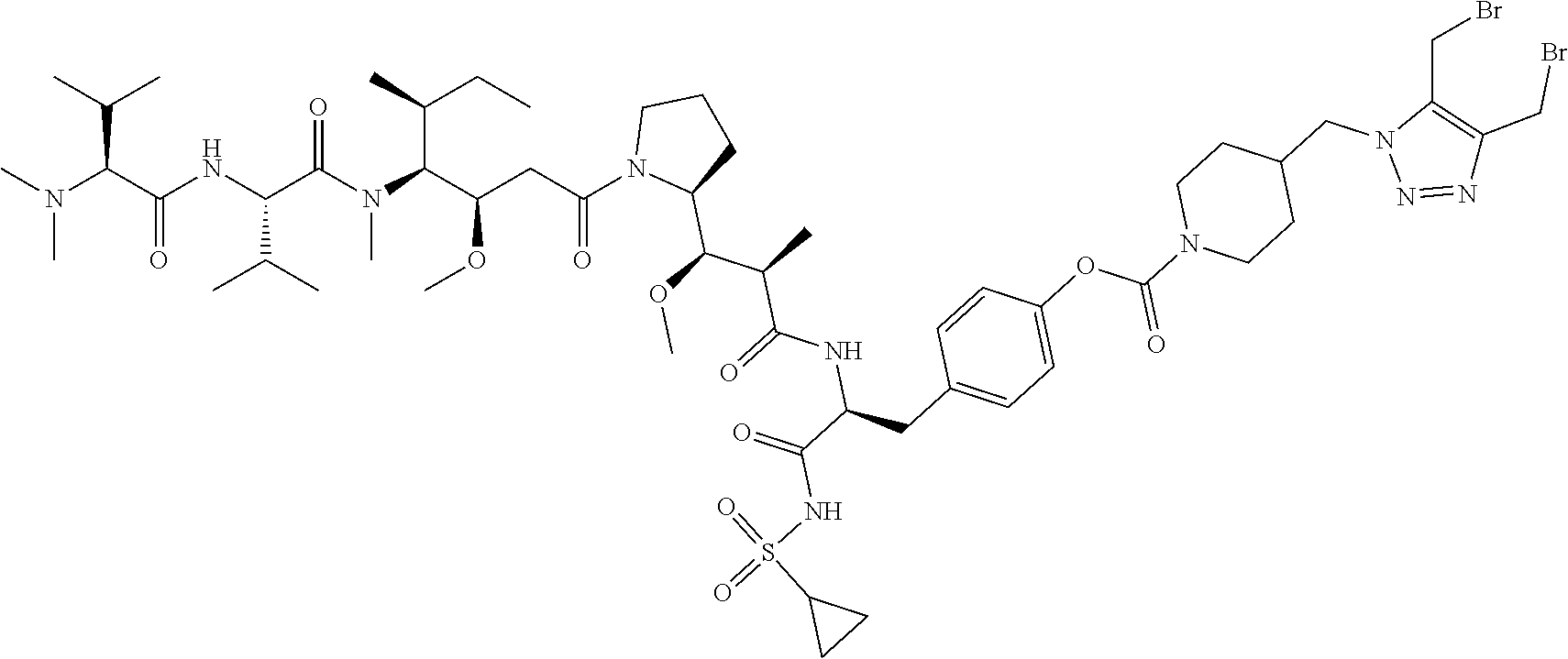












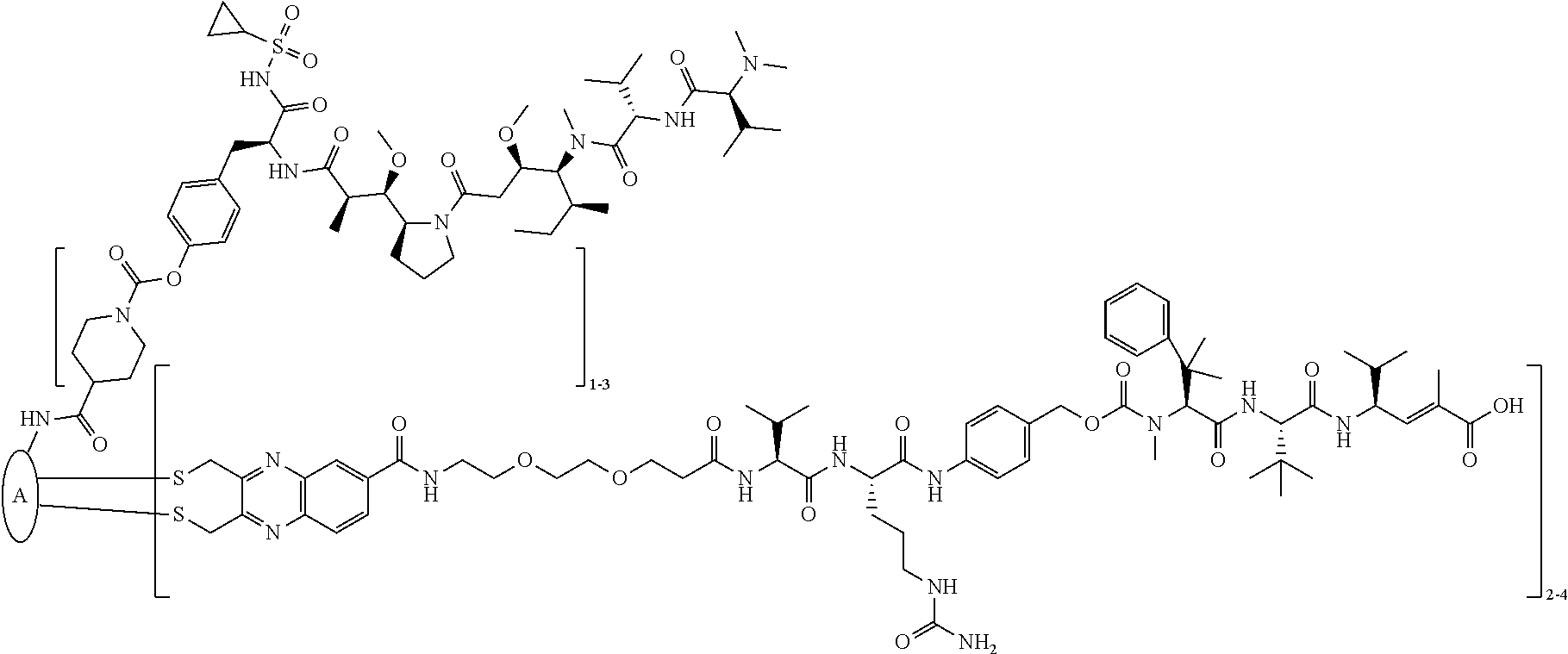



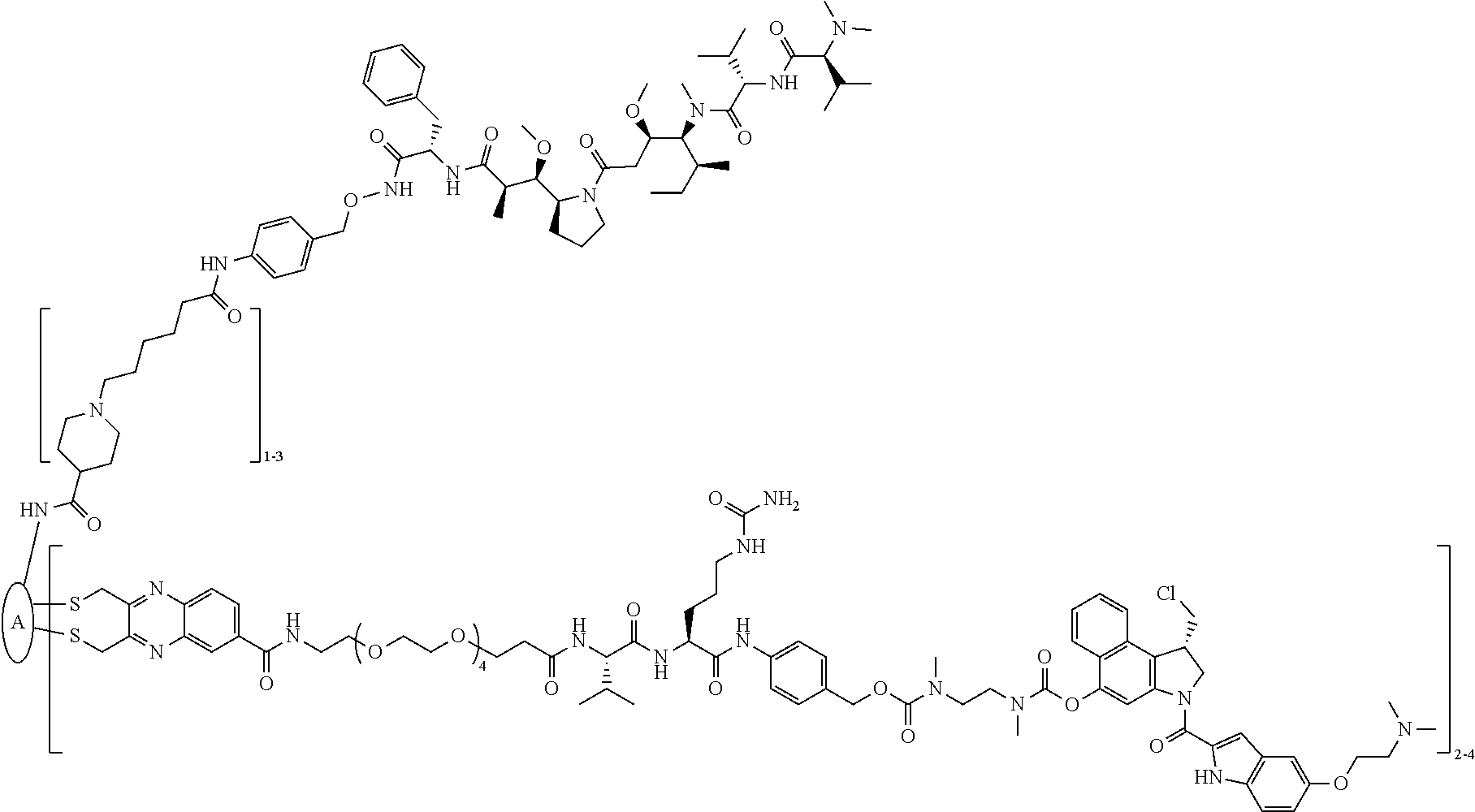
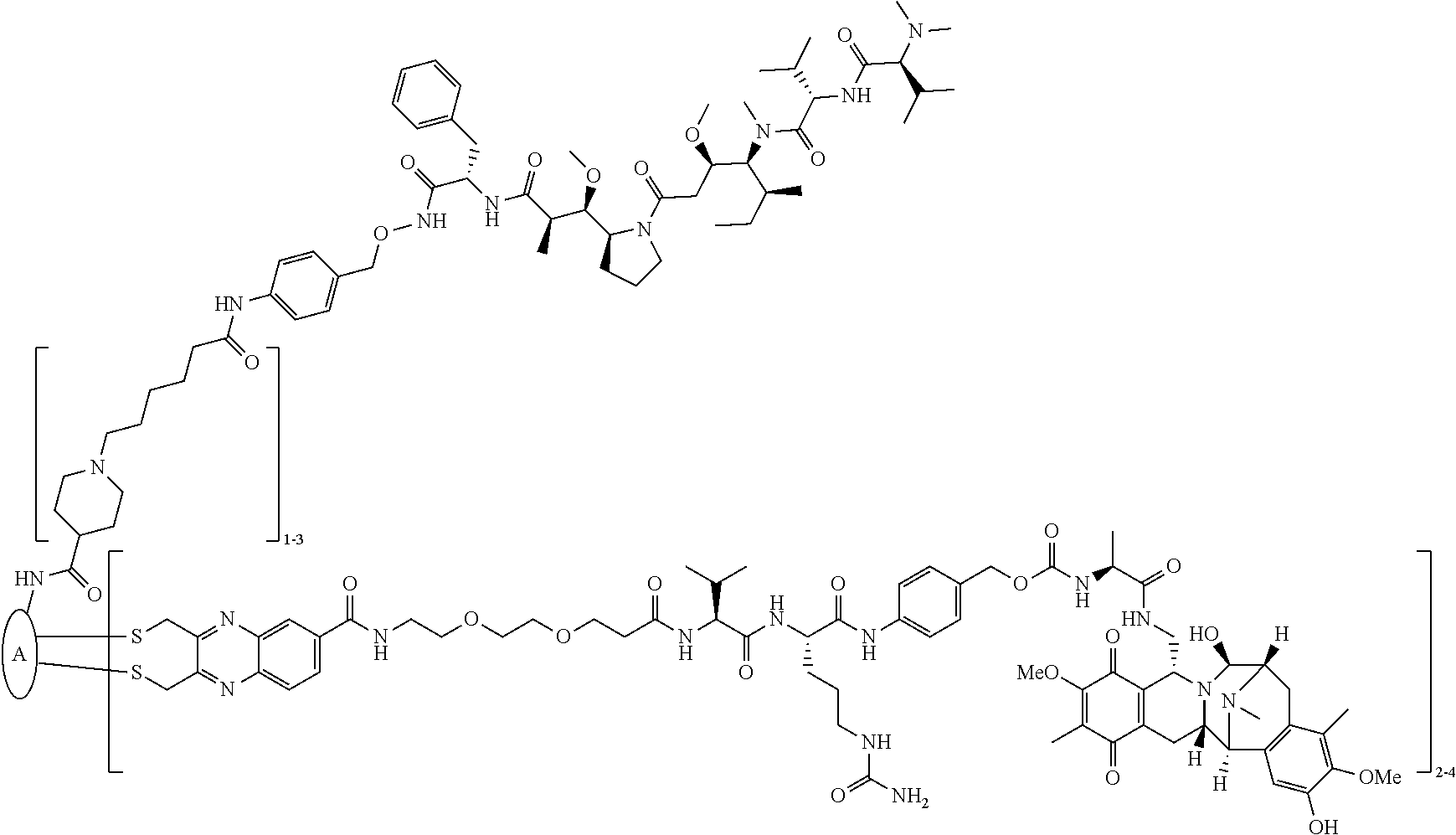

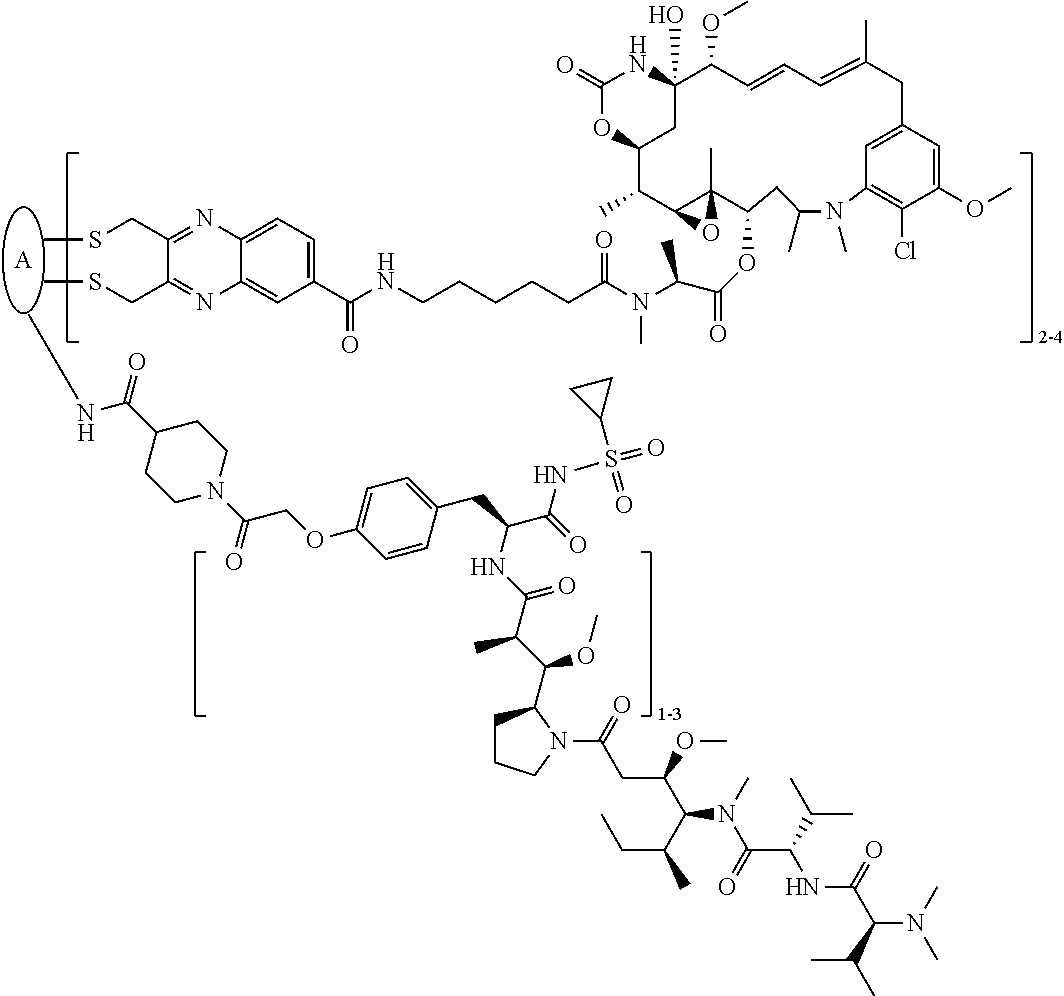

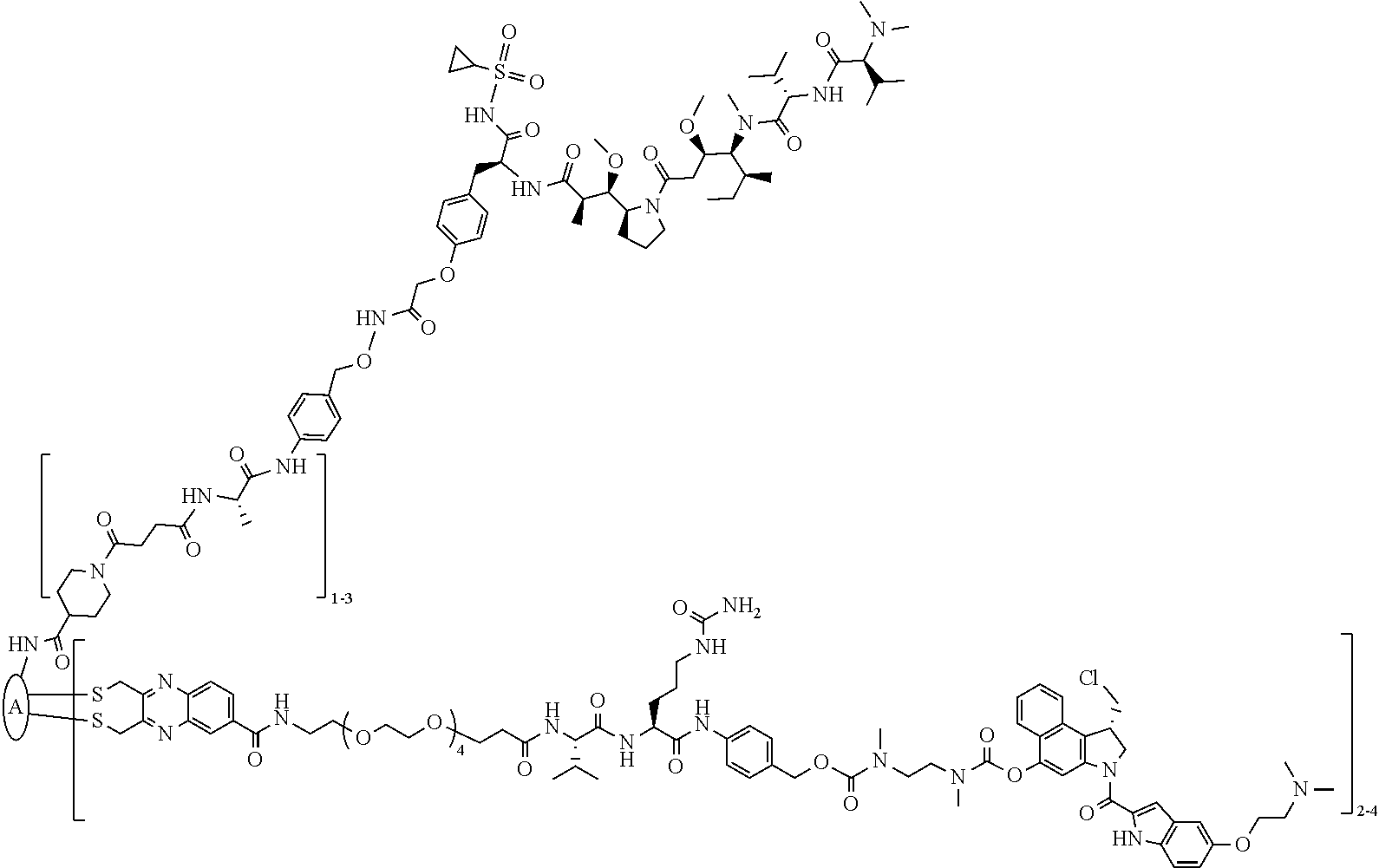



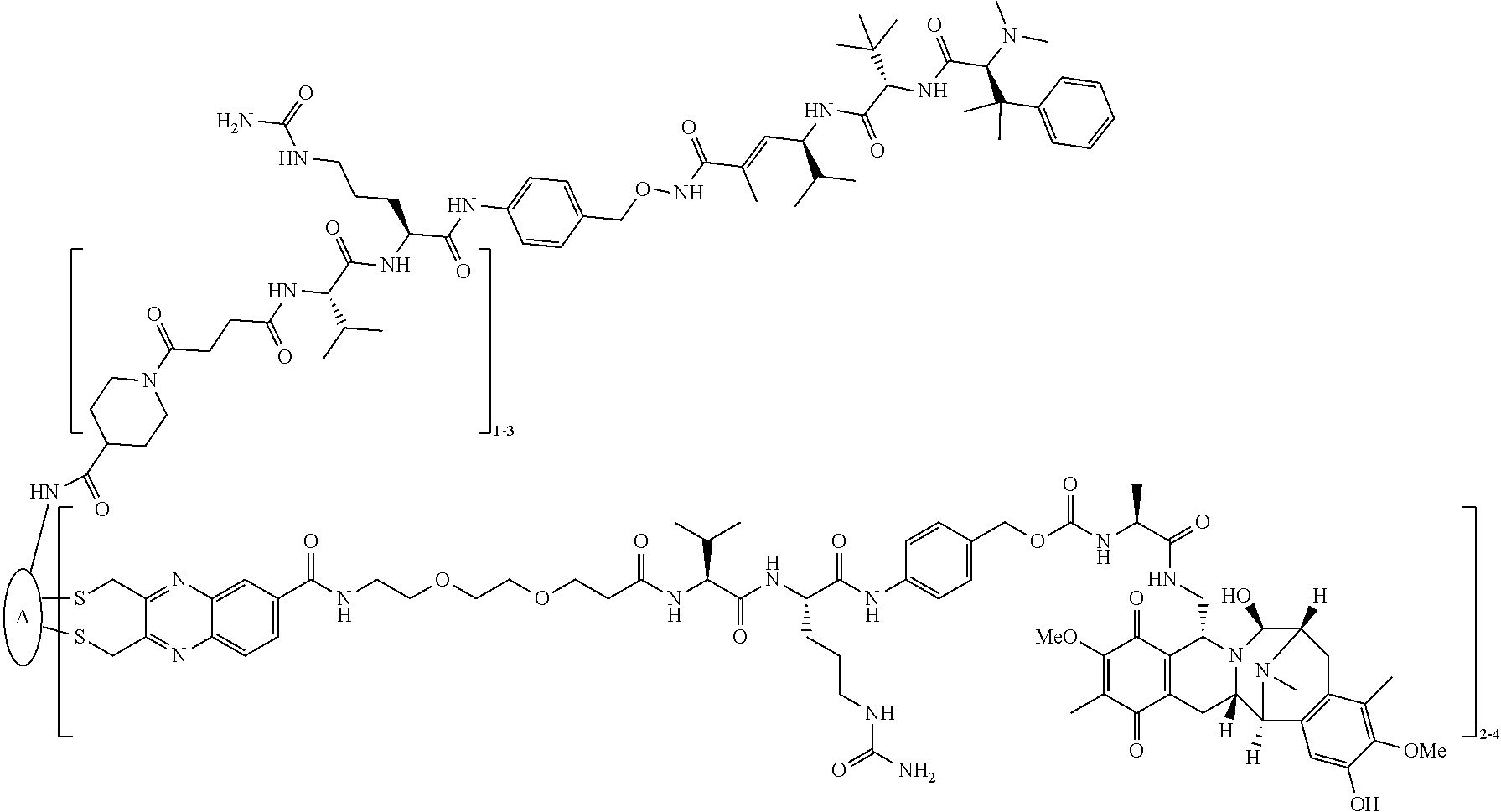






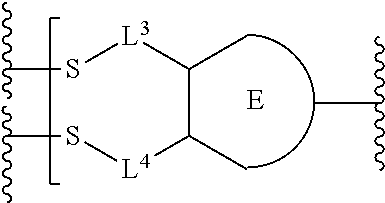



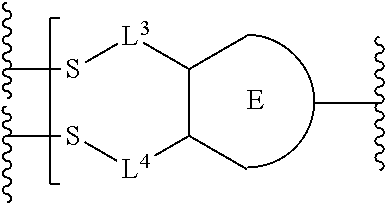

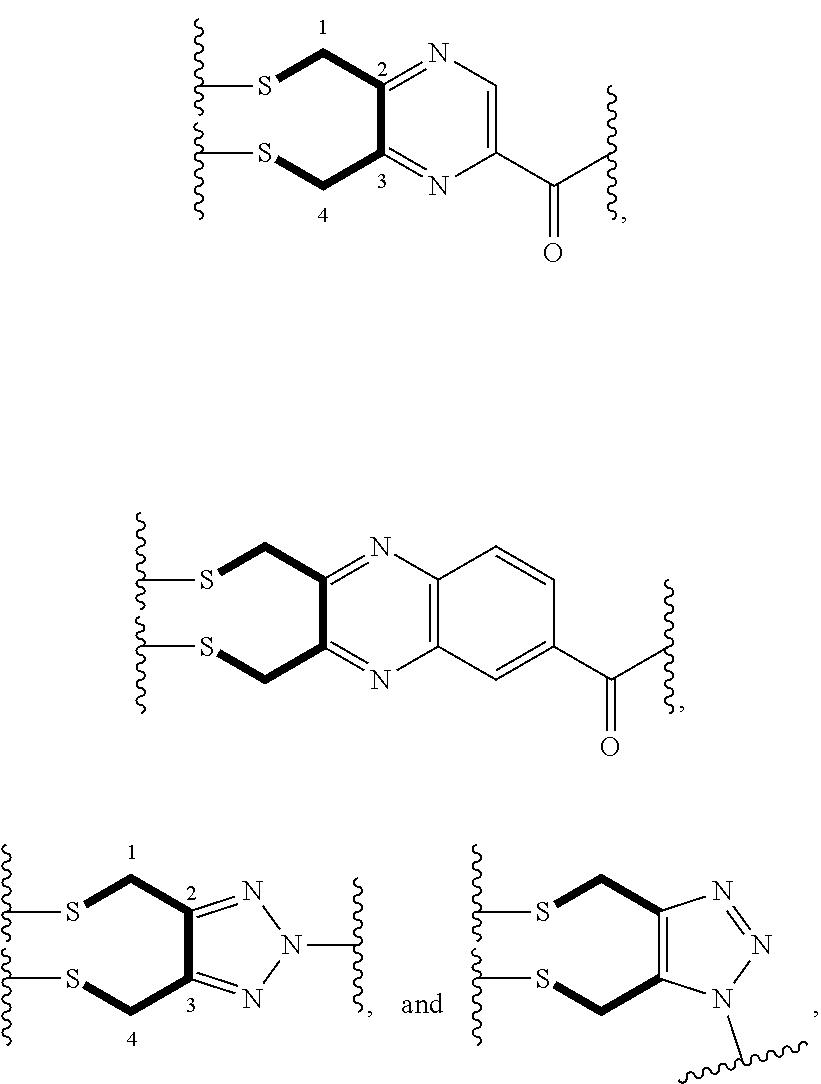



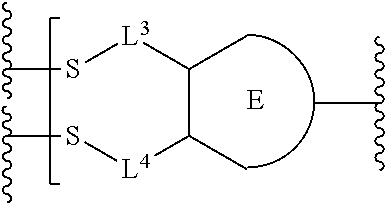





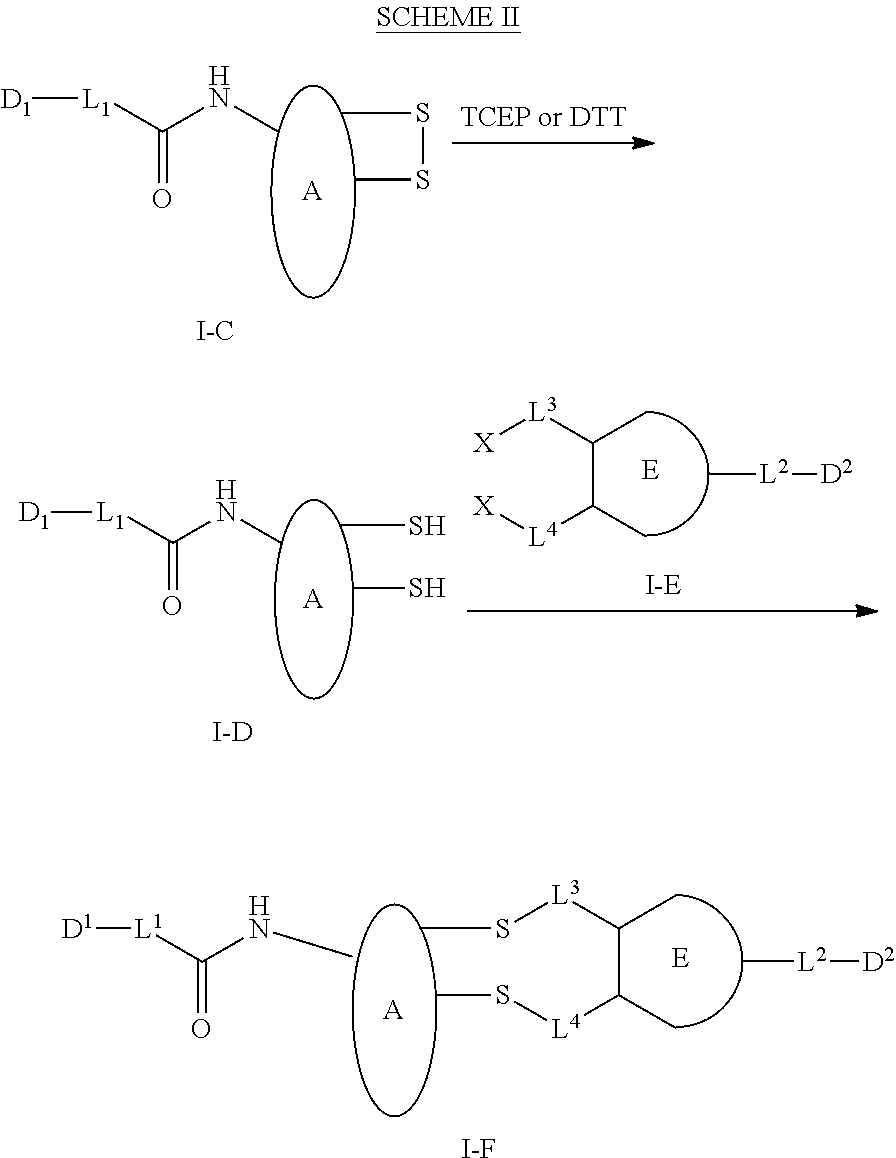











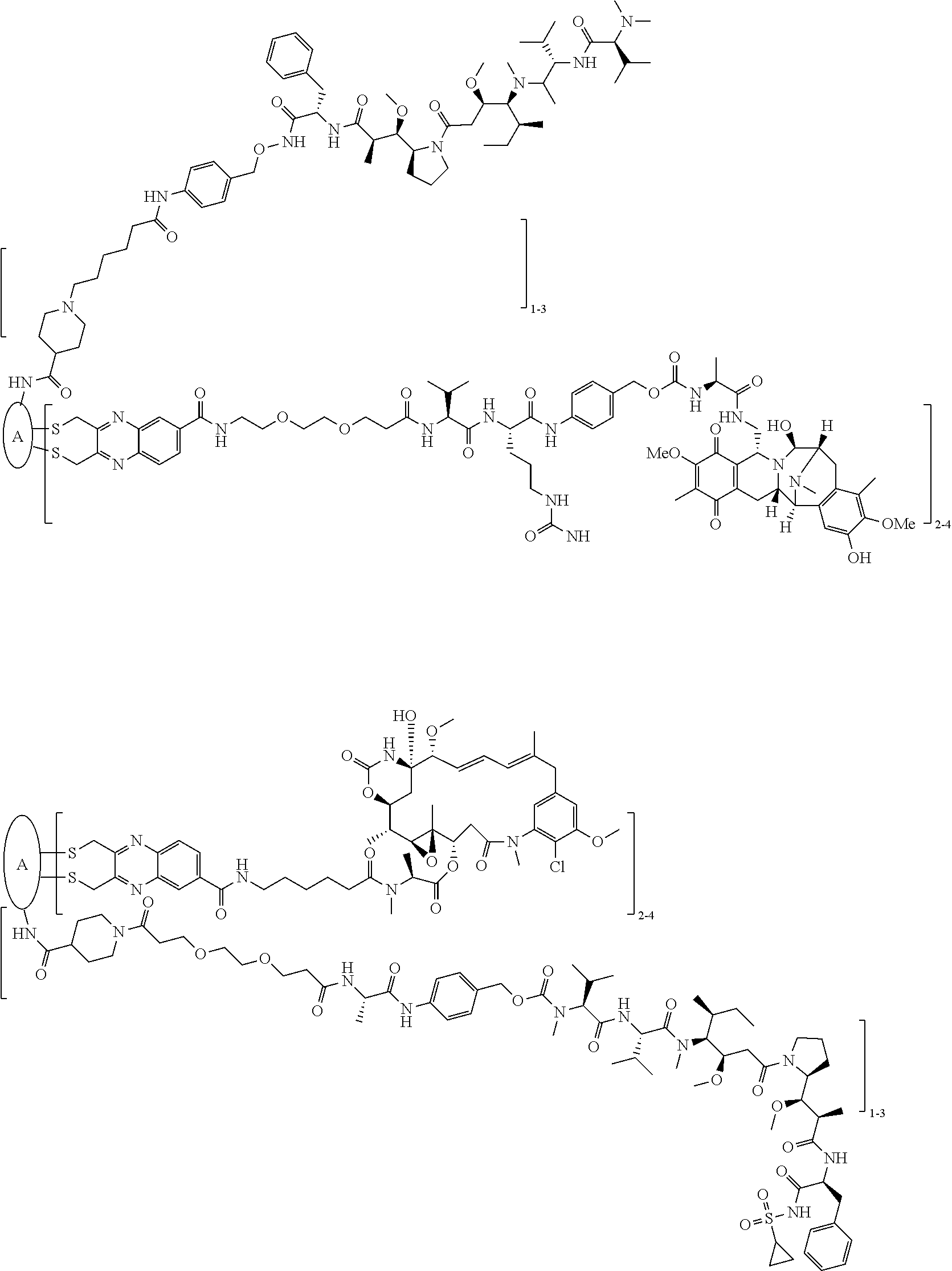












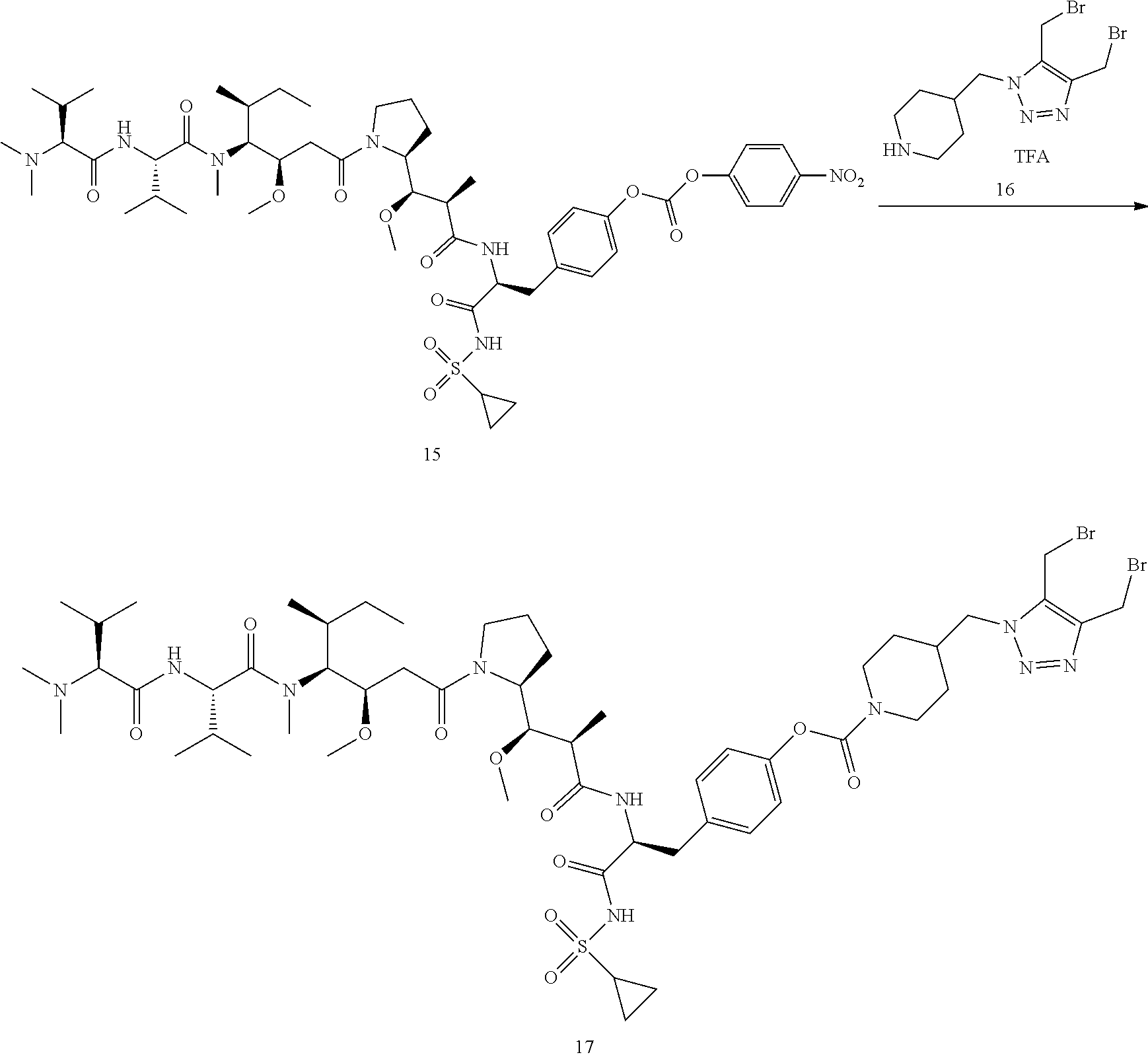












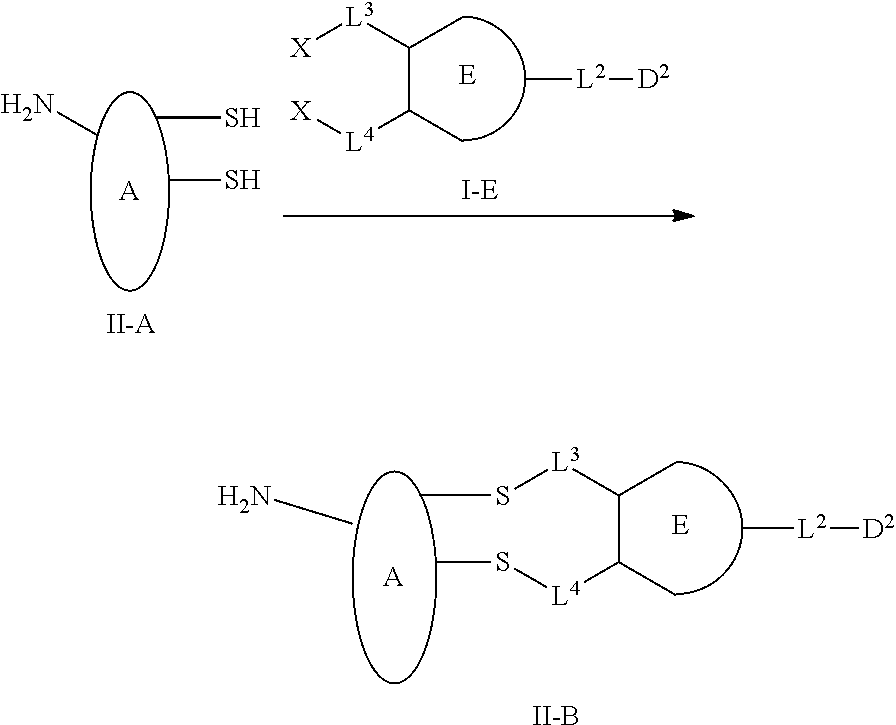



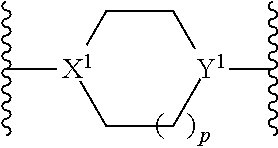






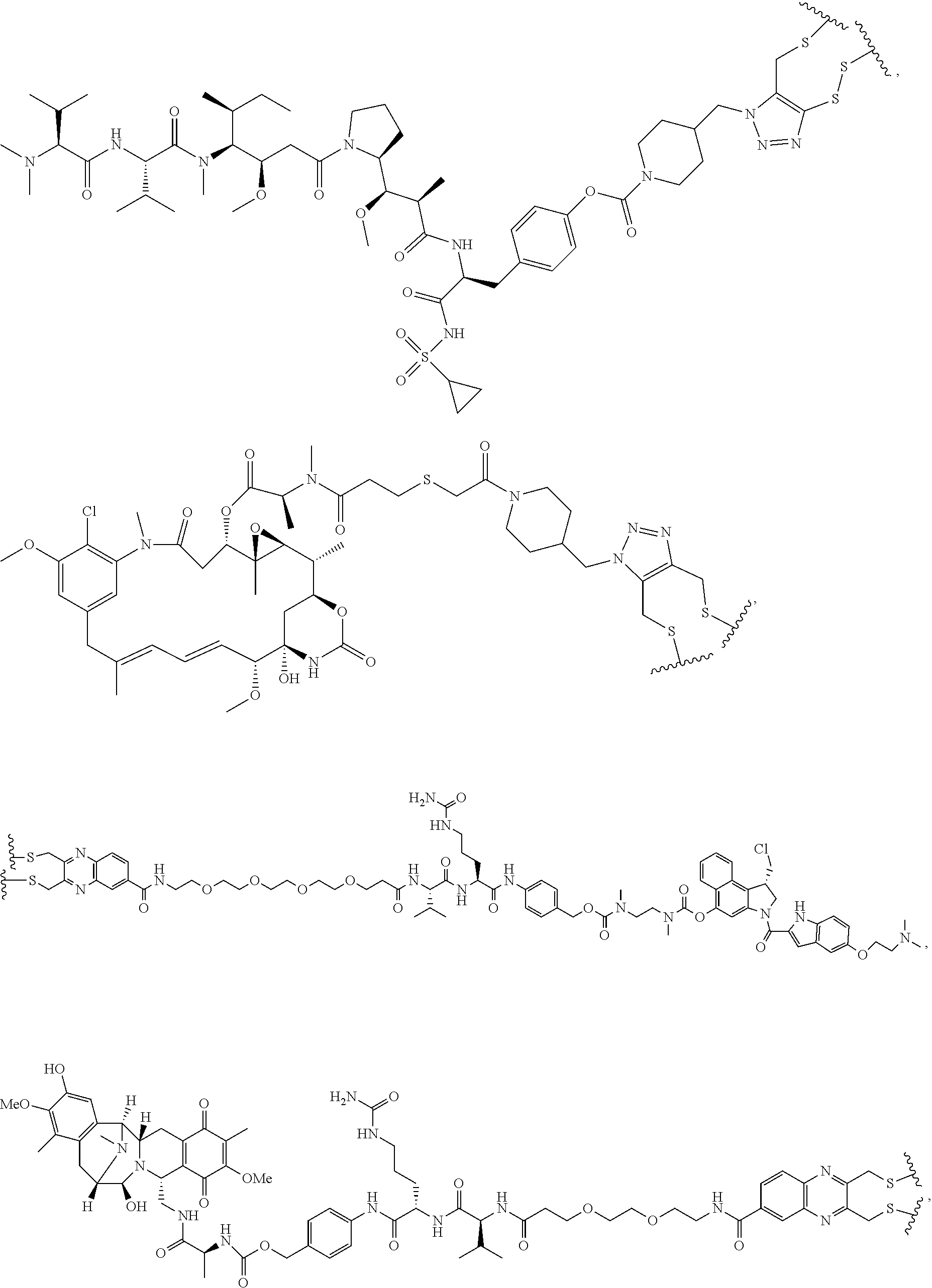






D00001

D00002

D00003

XML
uspto.report is an independent third-party trademark research tool that is not affiliated, endorsed, or sponsored by the United States Patent and Trademark Office (USPTO) or any other governmental organization. The information provided by uspto.report is based on publicly available data at the time of writing and is intended for informational purposes only.
While we strive to provide accurate and up-to-date information, we do not guarantee the accuracy, completeness, reliability, or suitability of the information displayed on this site. The use of this site is at your own risk. Any reliance you place on such information is therefore strictly at your own risk.
All official trademark data, including owner information, should be verified by visiting the official USPTO website at www.uspto.gov. This site is not intended to replace professional legal advice and should not be used as a substitute for consulting with a legal professional who is knowledgeable about trademark law.